A day after the presidential inauguration of Donald Trump, millions nationwide and around the world marched in support of women’s rights.
• Huge crowds converge on flagship Washington march.
• Hundreds of thousands at Los Angeles march alone
• Did you march? Tell us why.
• See the marches around the world.
- Share via
Fox News gives minimal coverage to women’s march and reinstates media divide

The three main cable news networks may have been equal in their wall-to-wall coverage of Friday’s inauguration and its festivities, but during Saturday’s coverage of the Women’s March on Washington, the historical divide between Fox News and its compatriots was firmly reinstated.
CNN, MSNBC and Fox News were all dinged by many viewers for choosing to open their Saturday morning coverage with footage of newly minted President Trump at the National Prayer Service rather than the estimated 500,000 marchers.
But by midmorning, while CNN and MSNBC had turned their multi-screened attention to the throngs of protesters, Fox, which had drawn a tweet of praise from the president for its coverage of the inauguration, continued to do just that.
Showing shots of the White House, Fox recapped the previous day’s events, discussed the swearing-in of the secretary of Defense and reported on the Trump family’s bowling in their new Pennsylvania Avenue home.
As the day wore on and millions marched and rallied around the country, commentators at MSNBC and CNN repeatedly expressed surprise at the number of people involved and invited a wide range of conversation about what such an event could mean for the country.
- Share via
A look at some of the protests that changed U.S. history (and others that didn’t)
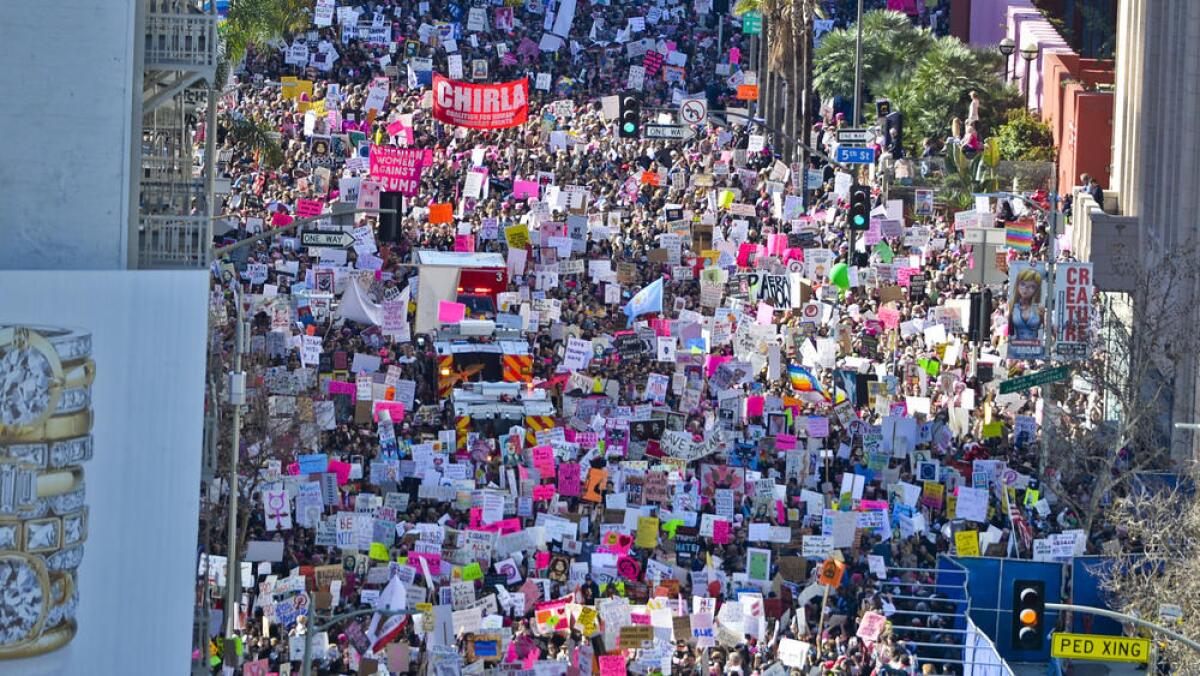
Like a great pink-capped wave, rolling from one edge of the country to the other, more than a million protesters marched through the streets of America on Saturday in an unprecedented show of discontent scarcely a day into the new Trump administration.
From resort towns like Bend, Ore., to the skyscraper-lined streets of New York City, it was an outpouring that surely gladdened critics of President Trump and lifted the faint spirits of Democrats crushed by his upset victory.
But once the protest signs come down and buoyant marchers tuck their “pussy hats” away in their closets, what remains is a stark reality facing the left-leaning throngs: a government in Washington run by the GOP and more than 30 state capitals where Republicans enjoy unchecked control.
Politically, that is the kind of breakwater that can dash the strongest wave.
- Share via
How well did Los Angeles work during Saturday’s Women’s March? Our architecture critic’s report card
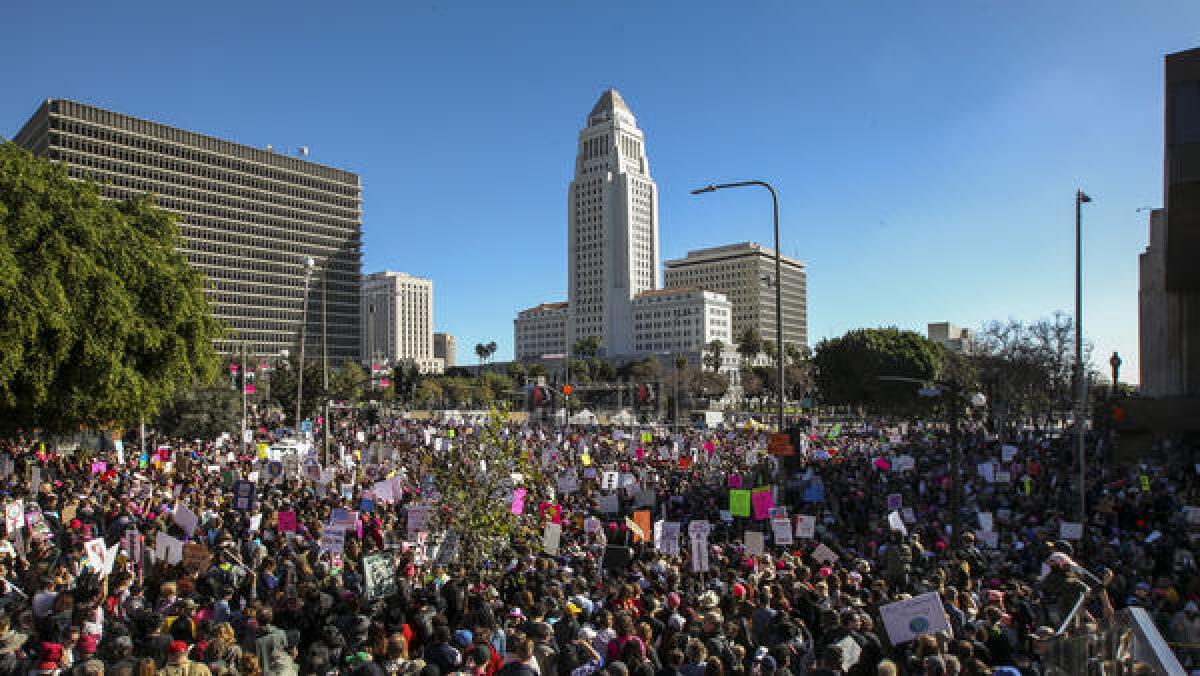
Any big political march is both a test of a city’s spatial limitations and an exercise in seeing and using that city in a new way. This may be especially true in Los Angeles, a city still trying to shake off an outdated reputation as a place without a significant pedestrian culture or vibrant public realm.
The Los Angeles edition of Saturday’s women’s march was in that sense another sign of the city’s continuing effort to redefine, or at least recalibrate, its public-ness.
What really struck me Saturday as I watched the march descend on Pershing Square and make its way to the foot of City Hall, was how certain spaces and corridors absorbed the unusual mass of humanity far better than others. The LAPD called it the largest gathering downtown since the immigration rights protests of 2006, attracting “hundreds of thousands” of people, according to multiple media reports.
At several moments, bottlenecks of these masses suggested overtaxed spaces and an inadequate infrastructure (and maybe also imperfect planning for the march itself). Other times, the crowd moved easily from one block to the next.
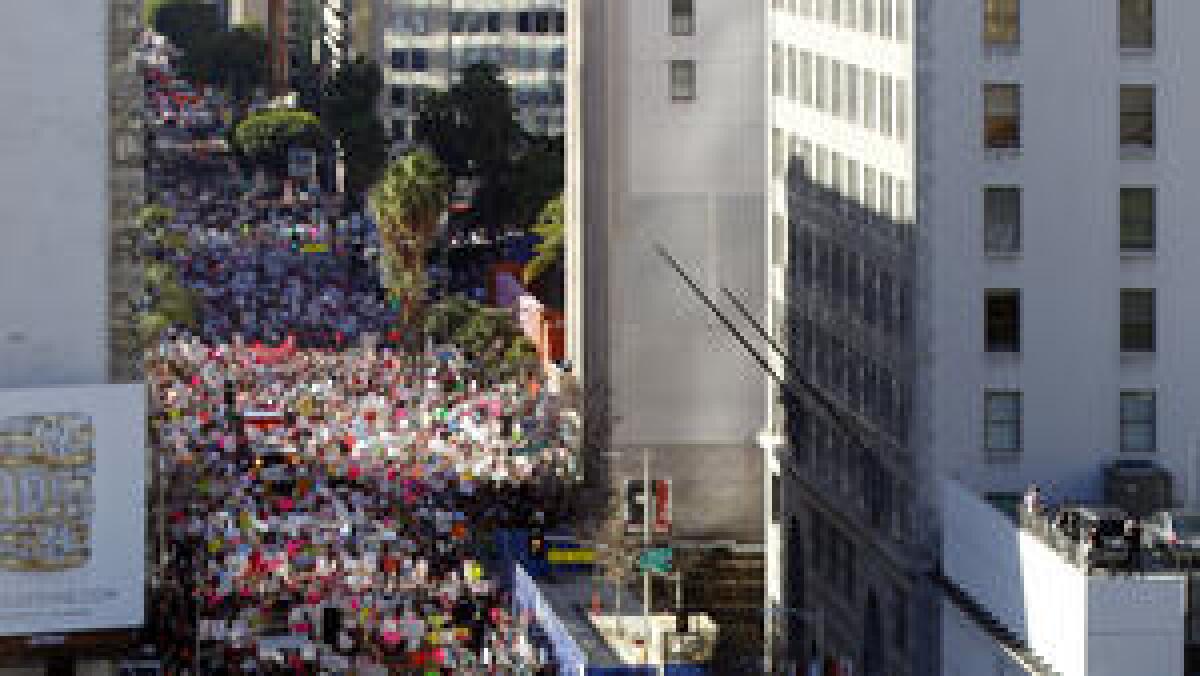
As I stood crowded in by a mass of marchers, it wasn’t difficult to think that ‘radical flatness’ would be an improvement in handling crowds of this size.
All morning, from what I could see, the marchers were jovial and relaxed, even when they seemed hopelessly stuck.
My short-form report card reads this way: low to middling marks for Metro and Pershing Square, high ones for Grand Park.
- Share via
Bras hung from trees outside the Women’s March, and other forms of feminine protest
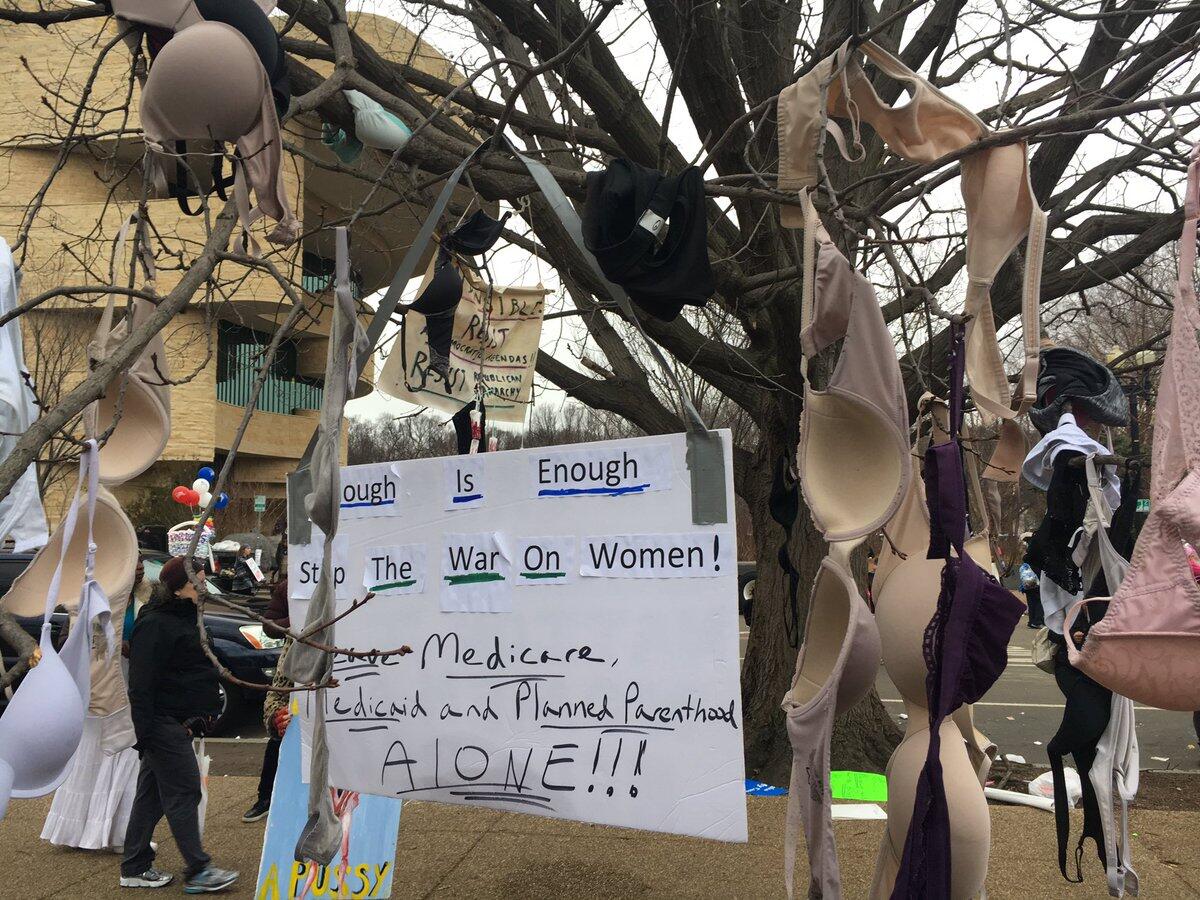
The trees were filled with bras outside the Women’s March on Washington. Behind the rally stage, branches were draped with brassiers, presumably from the participants in the march.
“Enough is enough! Stop the war on women. Leave Medicare, Medicaid and Planned Parenthood alone!!!” read one sign. “Resist!” said another.
Bras weren’t the only feminine intimate product used to send messages. Marchers wrote notes of protest on women’s sanitary pads that were affixed to a wall. Among the messages: “Women’s rights are human rights!” “My body, my choice!” “Nasty women fight orange trolls.” And with a drawing of a wire hanger, “Never again!”
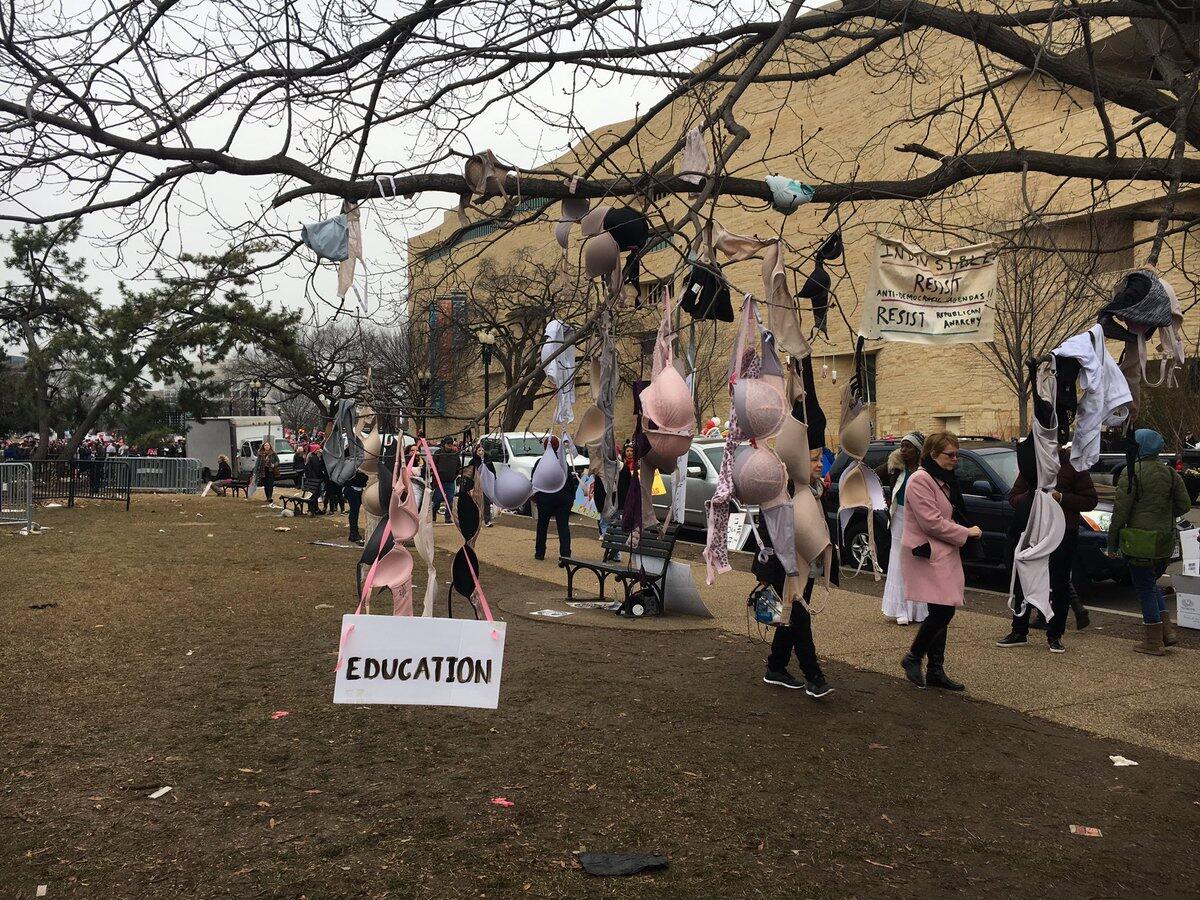
- Share via
‘With every drop of blood and every tear’: The artists who took to the streets for the L.A. women’s march
It is often artists who are a public voice of opposition. And artists need to bring that voice of opposition to this cause — with every drop of blood and every tear.
— Catherine Opie, artist
They began to gather just after 7 a.m. Saturday at the Good Luck Gallery, a small art space on Chung King Road in Los Angeles’ Chinatown. Owner Paige Wery, who showcases the work of outsider artists, threw open the doors in advance of the women’s march in Los Angeles to offer artists, friends and colleagues a base from which to attend the downtown action.
She also offered hot coffee, a bathroom and a table full of art supplies — so that last-minute arrivals could produce protest posters.
Paul Kopeikin, who runs Culver City’s Kopeikin Gallery, showed up with boxes of doughnuts and a fabric sign on his back that read “Not My President.”
“I think artists feel they belong to a group that is directly affected,” said Kopeikin, bearing a placard that reads “Unity!”
Read More----------------
Carolina A. Miranda has spent inauguration weekend following L.A.’s cultural institutions big and small to see how they are responding -- or not -- to the beginning of the Trump administration. Here are some of her other dispatches:
The Actors’ Gang joins theater world’s national call to create light for ‘dark times’
The L.A. artist who lip-synced Donald Trump’s inauguration speech as a clown
Artist R.H. Quaytman blocks public access to her MOCA painting in protest of Trump inauguration
A free comic offers artist ‘Resist!’-ance at the Hammer Museum
Artist Edgar Arceneaux on inauguration day at LACMA recalls Reagan’s inaugural gala
- Share via
Abraham Lincoln was at the Women’s March on Washington. See who else was there

Huge crowds converge on the nation’s capital for Women’s March on Washington.
- Share via
Gloria Steinem on Women’s March participants: ‘I think I just had to wait for some of my friends to be born’

The Women’s March on Washington may have been filled with celebrities, singers and all sorts of Hollywood A-listers, but it was longtime feminist and writer Gloria Steinem who really revved up the crowd.
Upon exiting the Women’s March after her keynote speech in which she emphasized that protest means more than hitting the “send” button, a crowd formed around Steinem. Mothers rushed up to introduce their daughters to her; protesters held out their signs for her autograph.
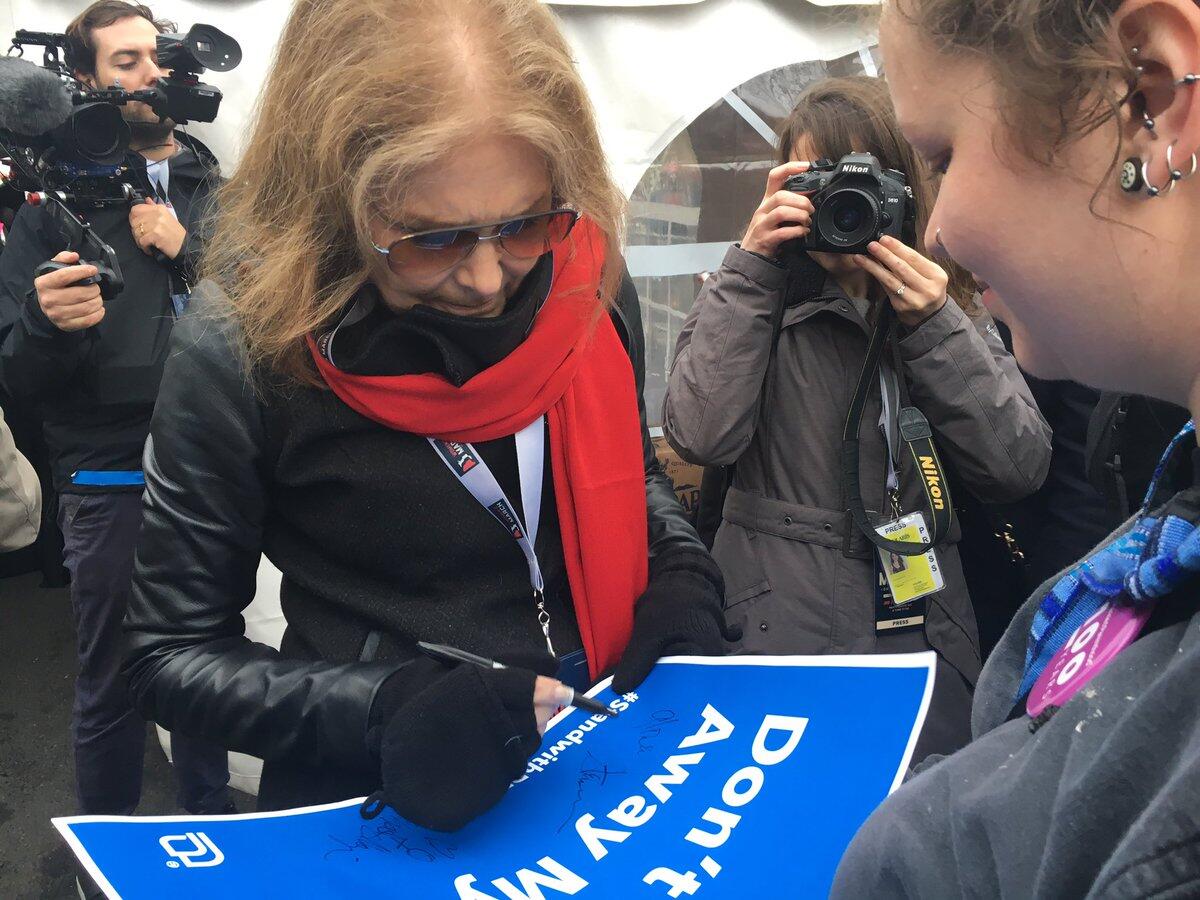
Even California’s Wendy Carrillo seemed excited to tell Steinem that she she is a candidate to replace Xavier Becerra in the 34th Congressional District. “I’m running!” Carrillo exclaimed.
We spoke with Steinem briefly and asked her to elaborate on the speech she gave during Saturday’s rally.
“We’re doing it,” Steinem said. “Pressing send does not allow us to empathize with other people. ... If you hold a baby you’re flooded with empathy. If you see somebody in an accident you want to help them. I love books, but [empathy] doesn’t happen from a book. It doesn’t happen from a screen. It only happens when we’re together.”
As for the day itself, Steinem appeared to be elated. “I think I just had to wait for some of my friends to be born,” she remarked.
And as the day turned to dusk, a flock of fans from behind the police barricades still chanted, “Glor-i-a, Glor-i-a.”
Watch Steinem’s speech below:
- Share via
London women gathered at Trafalgar Square
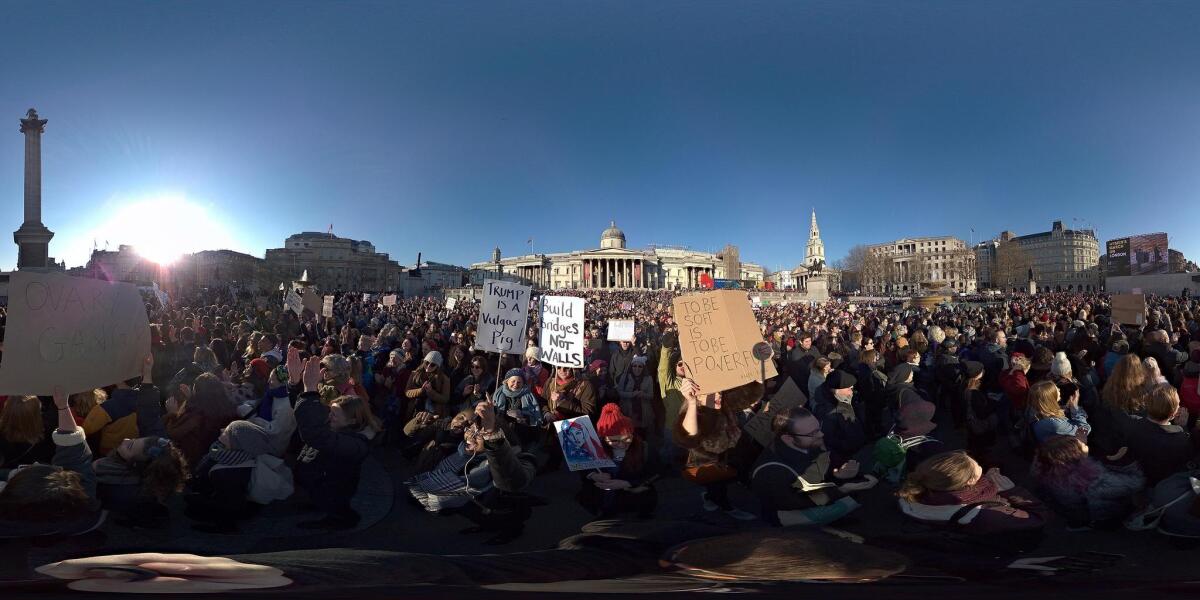
The atmosphere was jubilant at the London Women’s March as protesters walked through the capital loudly chanting “Build bridges not walls,” and “Stand united, we will never be divided.”
The signs held aloft against the election of President Donald Trump ranged from angry to comical.
“We shall overcomb,” said one of them, with a handwritten drawing of the new White House resident’s unruly hair.
The march began at the U.S. Embassy at about noon and wound its way to Trafalgar Square, where there was a rally and speeches.
Traffic was diverted, and there was a heavy police presence but a deep sense of solidarity and sisterhood among those present -- which included a large number of men and children as well as women of all ages.
“Things are really bad, we are really going backwards,” said Londoner Amy Woodrow Arai, 38, who attended with her mother, partner and 18-month-old son. “Thought this was going to be tough, but the atmosphere was really positive. It was so moving to see so many women there.”
London mayor Sadiq Khan attended, along with local politicians. Singer Lilly Allen was also among the crowds.
Labor MP Harriet Harman said Trump’s victory caused real concerns that fundamental rights would regress.
“This is a very important antidote to feeling passively disempowered and a sense that things are going to be pushed back,” she said.
Temperatures hovered around freezing for much of the day with bright blue skies overhead.
Organizers said up to 100,00 people attended, but police did not release official figures.
- Share via
The art of the satirical sign on display along the Mall
Los Angeles Times columnist Steve Lopez captured these images of the people and placards along the Woman’s March route in Washington.
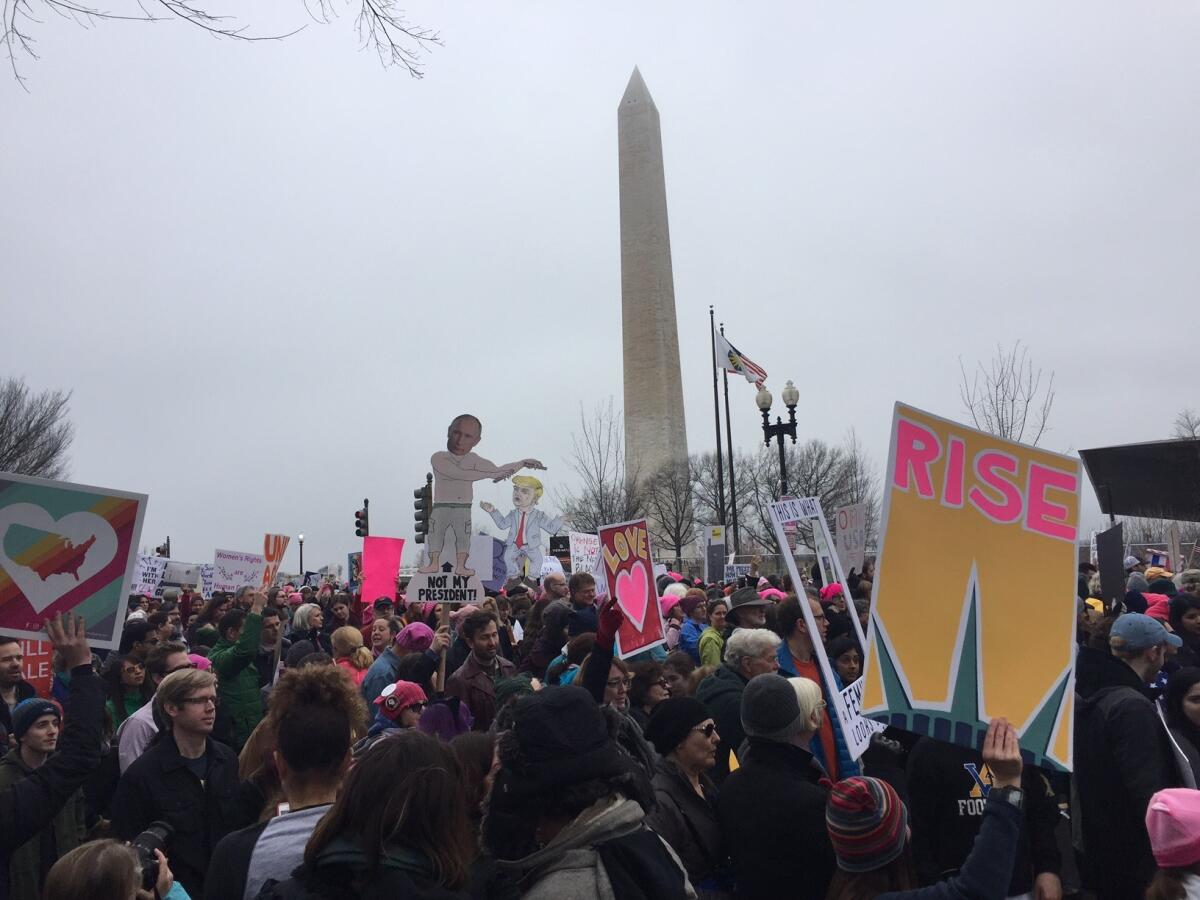
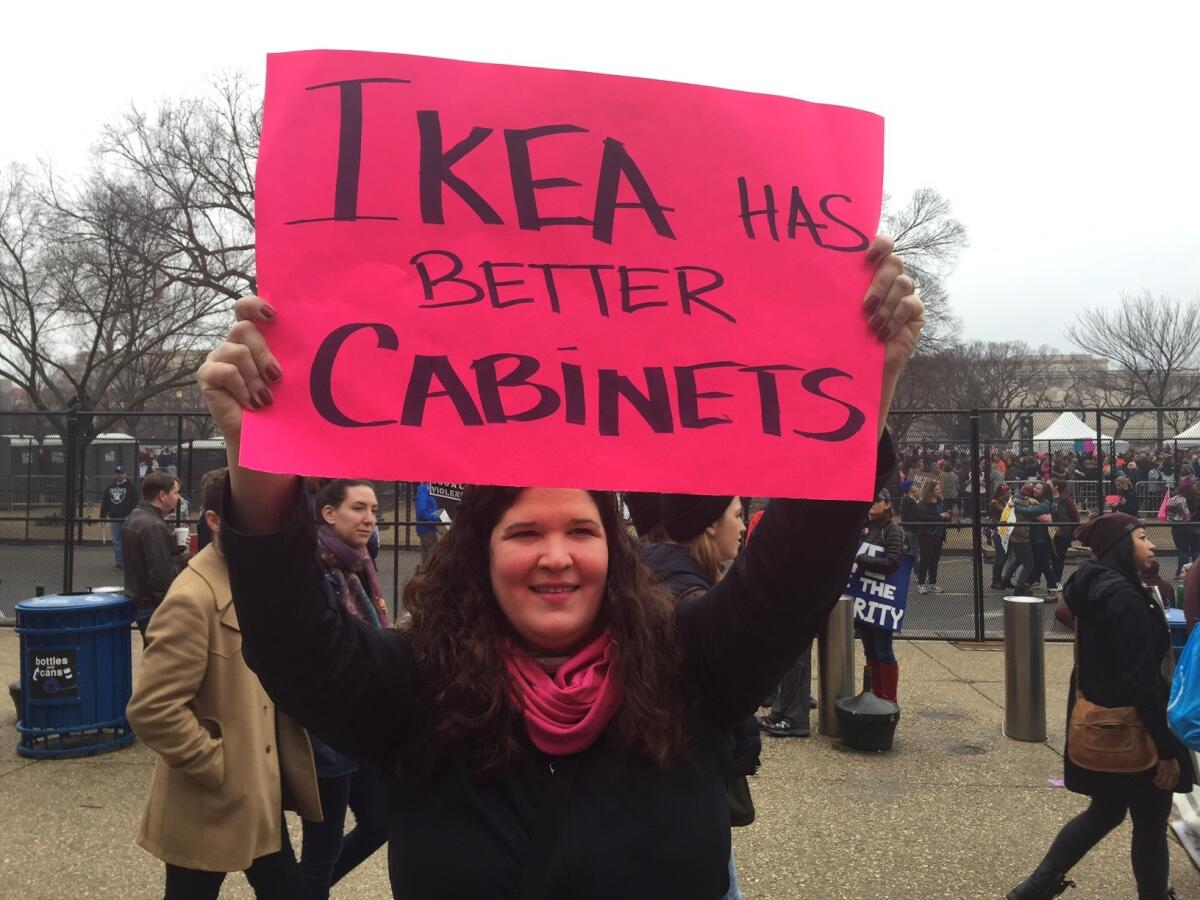
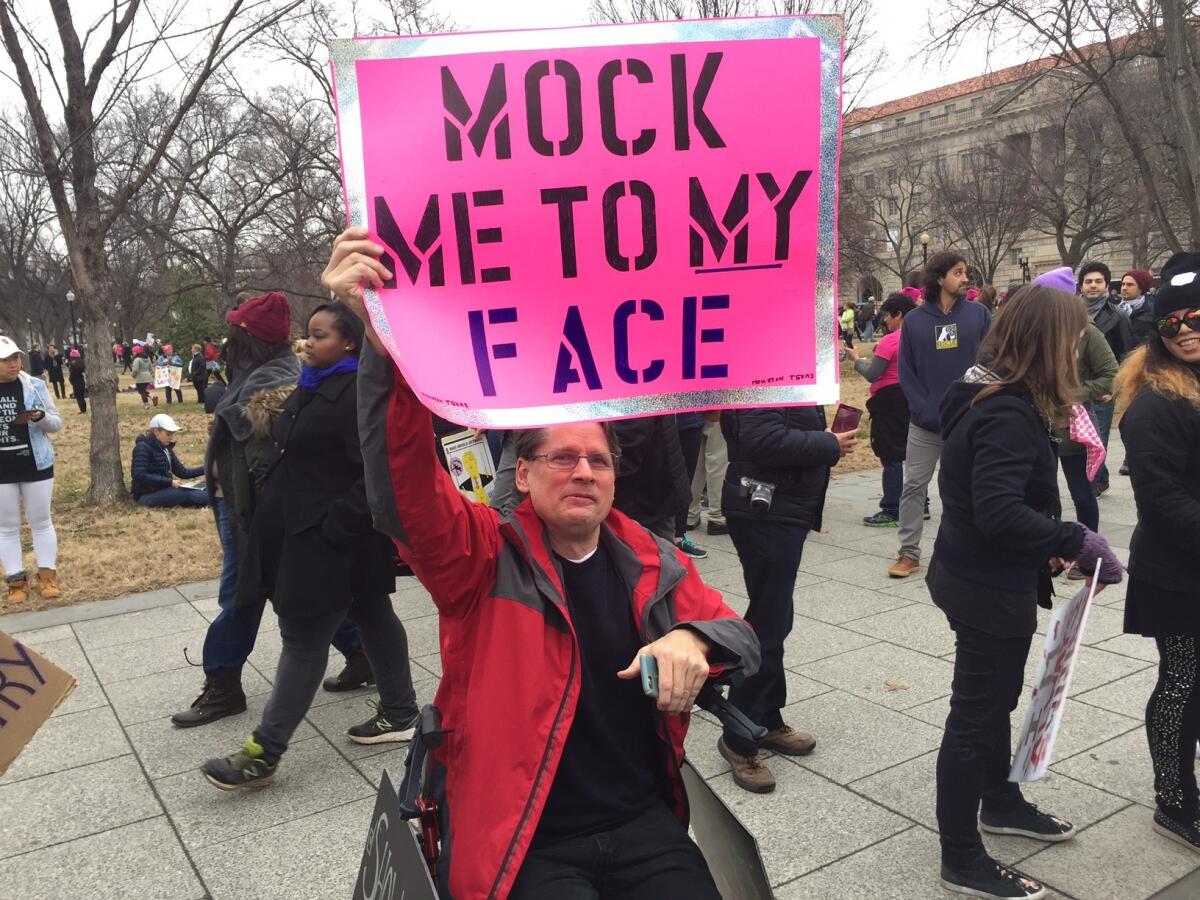
- Share via
Even in New York, hardly anybody ever saw a day like this
New Yorkers were struggling to to remember when there might have been more people out on the streets than during Saturday’s woman’s march -- perhaps back in 1982, when there was a huge anti-nuclear protest, or during the marches against the Vietnam War, or more recently, after the 2003 invasion of Iraq.
Organizers estimated the crowd Saturday at 250,000, about four times what had been expected, and some police officers said they thought it was larger.
Women and men, girls and boys, more people than even jaded New Yorkers could imagine, gridlocked the streets and sidewalks from Dag Hammarskjöld Plaza near the United Nations, jamming 42nd Street and Fifth Avenue as they headed up to Trump Tower, the permanent residence of the newly inaugurated president.
The soaring atrium of Grand Central Station was filled with balloons, signs and people in costume. “This was the Woodstock of your generation,’’ a 73-year-old retiree, John Molanphy, said while riding home on the subway in a hand-knitted pink hat. “I’d been to big demonstrations before in New York, but nothing like this.’’
The atmosphere was friendly. There was no sign of riot gear anywhere. Marchers waved at police and police often waved back. In front of Trump Tower, a march organizer balanced a loudspeaker on the roof of a police car to cheer on marchers while a police officer helped hold it in place.
To a large extent, the march had the blessing of the city leadership under Democratic Mayor Bill de Blasio.
“Look around you. We are together. We are united. We are always New York. Let’s march,’’ roared Chirline McCray, the mayor’s wife, who opened the rally at the beginning of the march.
In addition to official power, there was plenty of star power: Rosie Perez, Whoopi Goldberg, Helen Mirren and Taylor Schilling of “Orange is the New Black.’’
Although Donald Trump is a native New Yorker, many in his hometown aren’t fans.
“We hate him because we know him,’’ said Nadine Hoffman, a veteran activist.
No surprise, since New York is one of the creative capitals of the country, the march turned into an outdoor art gallery of imaginative posters, many of them featuring cats (a reference to a video leaked during the campaign in which Trump referred to female anatomy), and others with coat hangers (a reference to fears that women will be forced to return to the days of illegal abortions.)
A few samples of those that were clean enough for a family newspaper.
“You can’t comb over corruption.”
@fakesign. Highly overrated.
Just say Nyet.
It appeared there were nearly as many men as women in the crowds.
One man carried a sign that read, “I’m with her and her and her and her and her.”
Another carried a young baby in a backpack with an attached sign that read, “My papa is a feminist.”
- Share via
Jesse Jackson photobombs Cher interview at Women’s March on Washington
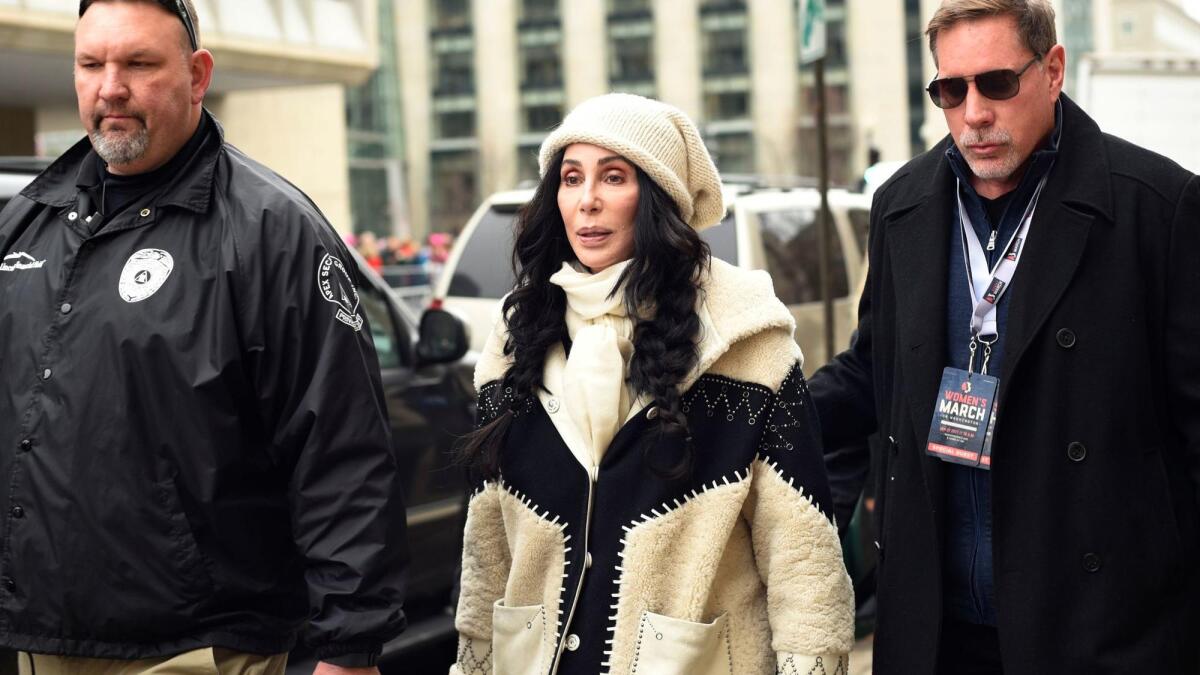
Cher appeared at the Women’s March on Washington to lend her support to the movement sparked by the reaction to Donald Trump’s election.
“I want to let people know that I’m here for them and I believe in this movement,” she said. “I want people to go away from here and join organizations and keep protesting.”
When asked how she as an artist will reflect the change she wants to see in America, she said, “I want to protest. I want to speak up. I want to lend my name. I want to do everything that’s possible that I can think of. I’m just so astonished that everybody came.”

At that point, an old friend of Cher’s stuck his head into the shot and joked that maybe he should open her next show. It was civil rights leader Jesse Jackson.
“We’ve known each other forever,” Cher said with delight.
When Jackson was asked how many Cher concerts he’d been to, he slyly said, “Since I was a kid.”
This brought out a big laugh from Cher, who hit Jackson on the chest and teased, “Since you were a kid!”
They both laughed together and then moved off into the crowd.
See the full video below:

Cher and Jesse Jackson at the Women’s March on Washington.
- Share via
An organizer of 2006 immigration march speaks out: Today’s crowd is younger, more diverse
Jorge Rodriguez, 64, has been involved in civil rights movements since he was a teenager. He participated in demonstrations to protest immigration raids and to call for amnesty for immigrants living in the country illegally during the 1970s and 80s.
Rodriguez, who lives in South Pasadena, was also one of the organizers of the immigrant-rights protest of 2006 that drew an estimated 500,000 people.
Glancing at the sea of people that stretched from First Street to Grand Avenue, Rodriguez said he noticed the crowd was younger.
“It’s great,” he said. “The fact that there’s more women here is a testament of the resistance, and it’s not just women, but families.”
Rodriguez said the crowd was also more diverse than the 2006 immigration march.
“I knew it was going to be a big march because people are upset and they want to fight,” he said. “People won’t want their rights taken away.”
Rodriguez is hoping that the march will inspire people to find ways to fight against injustice and hold elected officials accountable.
“I have hope,” he said. “There’s a new generation that is stepping up to stop injustice.”
- Share via
The march in Washington is winding down
- Share via
Indigenous women were among the last to sing along Constitution Ave.
The women’s march has seriously wound down. Several hundred demonstrators are still massed in front of the White House, but Constitution Ave. has finally been cleared.
The final contingent to march on Constitution was an indigenous women’s group, Indigenous Women Rise, that sang while marching before coming to a stop in front of the White House and giving prayer.
After giving each other hugs, the women melted away, and police vehicles began to drive through the street and urge stragglers to get back on the sidewalks.
- Share via
Las Vegas marcher says Trump made a bad bet against Obamacare
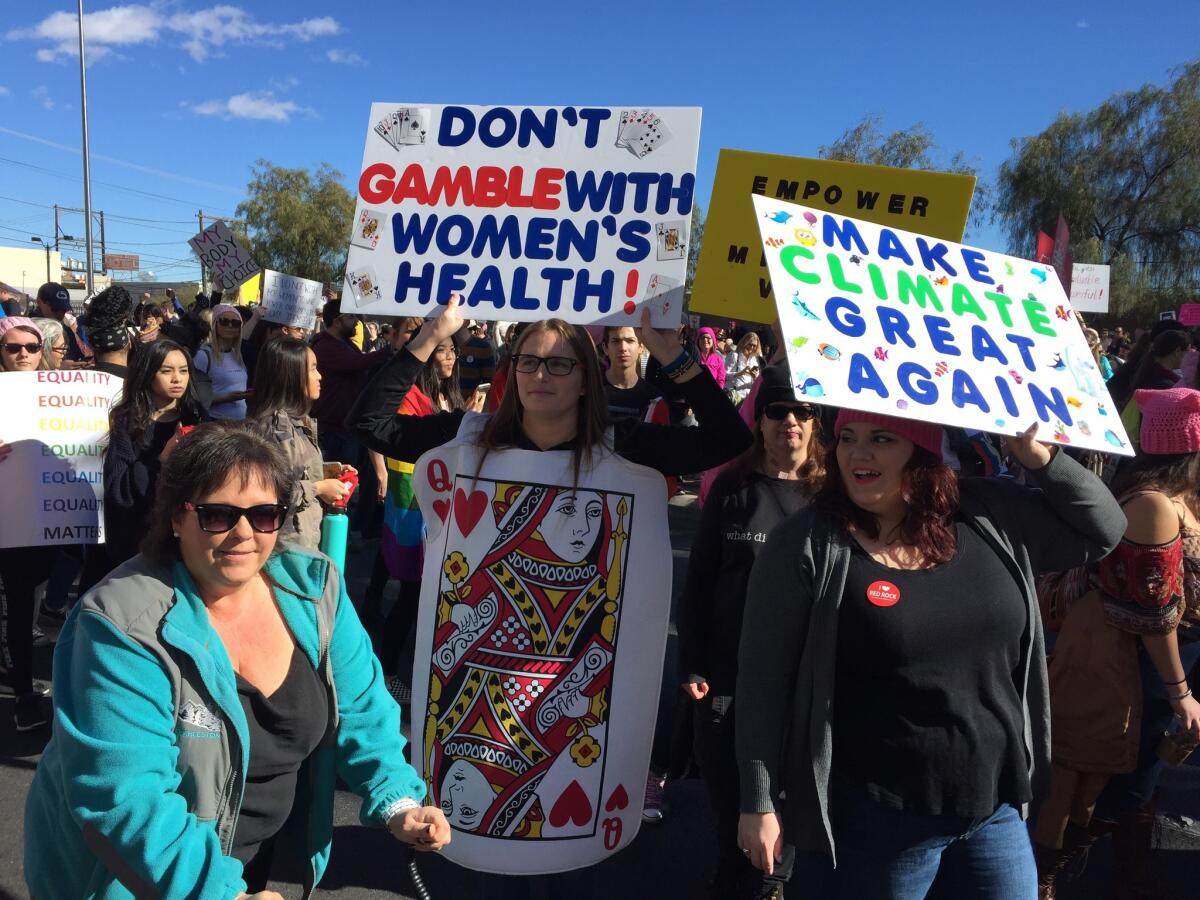
Amanda Grossi, a freelance translator, was in danger of losing her jobs because she couldn’t afford glasses. Then came the Affordable Care Act. Suddenly, seeing her work was within sight.
“People forget that basic needs like glasses allow me to work and contribute taxes and not be a burden on the system,” Grossi said at the Women’s March in Las Vegas on Saturday. “It’s an investment.”
The 28-year-old was upset when President Trump signed an executive order Friday to “ease the burden” of the act known as Obamacare.
Being a Las Vegas native, she thought the best way to make a statement at the march was to let Trump know he was making a bad bet. So she borrowed her sister’s Halloween costume – a queen of hearts – and made a sign that read “Don’t gamble with women’s health.”
Grossi said everything from Planned Parenthood services to just being able to get prescription glasses was too important to the economy to jettison now.
She was one of about 4,000 people marching down Fremont Street, past the El Cortez Casino, a few bars with late-night revelers who were now late-morning stragglers, and the Wee Kirk O’ The Heather Wedding Chapel. They stopped in front of Foley Federal Building on Las Vegas Boulevard, with the iconic Stratosphere Hotel and Casino as a backdrop.
Grossi said marching made her feel like she was making a statement the day after Trump “took away my voice.”
But she said the march had to be just the beginning. She hoped people would work to get Democrats elected in the mid-term elections in 2018 and gain control of Congress.
She then held up her sign and joined the crowd in chanting,
“justice, peace and equality for all — stronger together we won’t fall.”
- Share via
Call to arms from the National Mall: ‘Tweet all people kindly’

Several times at the Women’s March, I couldn’t move left, or right, forward or back.
Women, and more than a few men, swarmed onto the National Mall from every direction to march in protest of Donald Trump on his second day as president.
Speaking of crowd size, it should surprise no one that Trump spent part of the day moaning about crowd estimates for his Friday inauguration.
In more ways than one, size matters to Trump.
He must have looked out the window at some point and noticed that the protest march appeared larger than the celebration march, and he took a shot at the media for getting it wrong, calling reporters dishonest.
Among our sins, he said, we falsely accused him of having feuded with American intelligence agencies.
We did?
This from the guy who compared American CIA officers to Nazis.
“This is what democracy looks like,” marchers chanted throughout the day.
Although women’s issues were central to the Women’s March, demonstrators were there because of concerns including environmental policy, bigotry and immigration.
A man seated in a medical chair held up a sign that said: “Mock me to my face.”
“Make America think again,” said another sign.
Dean Cannon, 8, from Atlanta, held up a message for the new president: “Tweet All People Kindly.”
Bob and Mary Helen Harris sat on a bench at the end of the march holding a sign:
“Been Marching Since 1963.”
“Trump has been frankly frightening, with his demagoguery and misogyny,” said Bob, a retired Presbyterian minister.
They said this wouldn’t be their last march.
- Share via
In Israel, marchers criticize talk of moving U.S. Embassy to Jerusalem
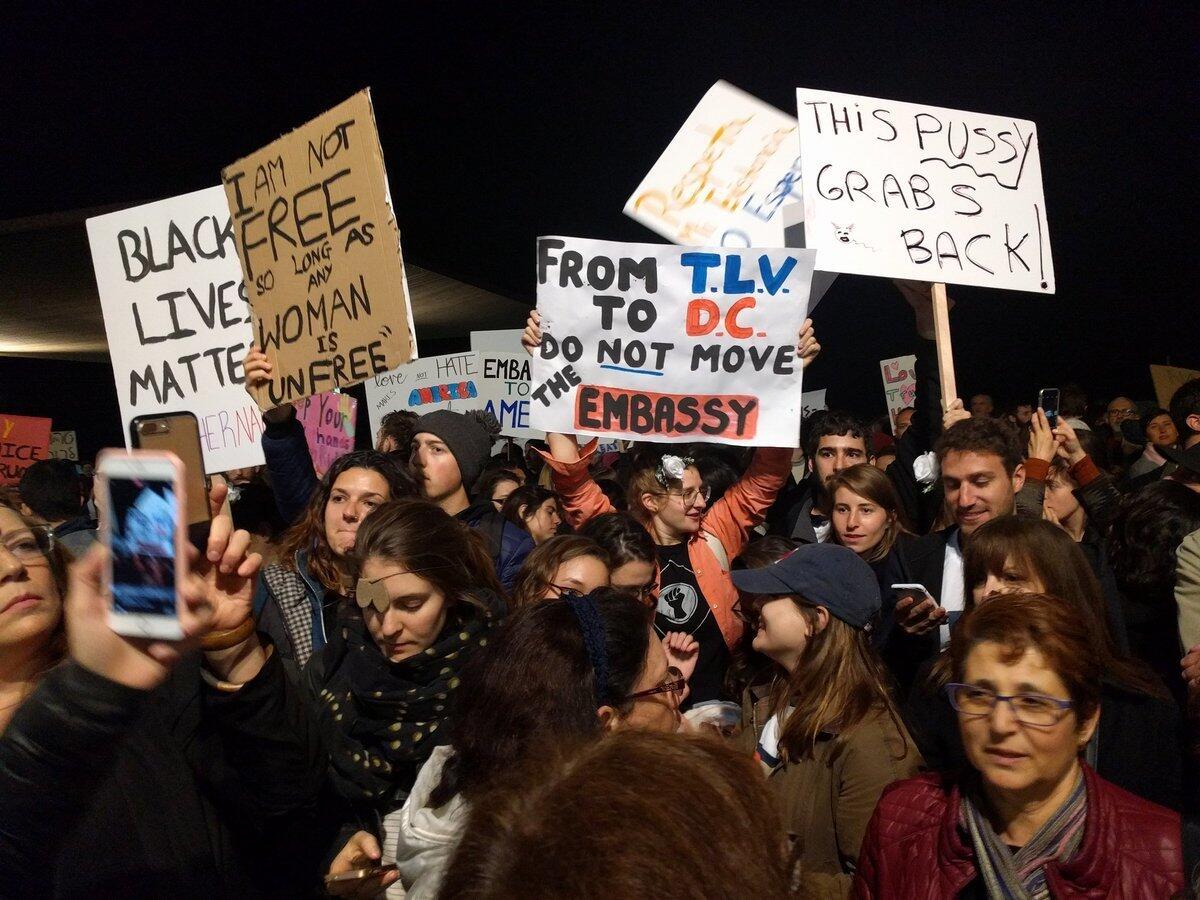
Standing in a chilly sea breeze, hundreds of American expatriate demonstrators gathered outside the U.S. Embassy in Tel Aviv to protest what they described as President Trump’s slights against women and minorities.
Demonstrators were careful to keep the focus local, though, singing Hebrew prayers for peace, protesting Trump’s promise to move the U.S. embassy to Jerusalem, and holding up signs critical of the new president’s emerging bromance with Israeli Prime Minister Benjamin Netanyahu.
“The question is what we in Israel can do as an act of resistance against Trump,’’ said Larry Derfner, a left-wing blogger and columnist. “I would say that any act of protest, of getting in people’s faces, against the Netanyahu administration and the occupation is by direct extension an act of resistance.”
Derfner also slammed Trump’s nominee for ambassador to Israel, real estate lawyer David Friedman, for referring to the liberal American Jewish political advocacy group J-Street as “kapos.”
“We have to organize a boycott of him,’’ said Derfner, an Israeli American.
Speakers called on the crowd to express solidarity with Palestinians in Israel and in the West Bank who have had homes demolished by Israeli authorities.
Evan Kent, a 56-year-old Jerusalem resident and former cantor at Temple Isaiah in West Los Angeles, said he made the trip to Tel Aviv to support demonstrators in the U.S. and around the world. He said he was disturbed that Trump’s victory is emboldening Israel’s right-wing government.
“The right wing in Israel has formed an alliance with Trump, thinking he’s giving them an imprimatur to be more right-wing, it’s a little disconcerting,’’ he said. “Trump’s personality indicates he will only do what’s best for him, and not what’s best for Israel. The people who think he’s best for Israel are sadly delusional.’’
- Share via
L.A. Mayor Eric Garcetti: ‘It doesn’t matter who is at the top, it matters what we do at the bottom’
Los Angeles Mayor Eric Garcetti revved up the crowd at the women’s march, telling them: “Don’t be afraid.”
“It doesn’t matter who is at the top,” Garcetti said, drawing raucous cheers. “It matters what we do at the bottom.”
The mayor, who campaigned for Hilary Clinton during the election, said the fight would continue for abortion rights, same-sex marriage and affordable healthcare.
“Today we speak out, but tomorrow we act out,” Garcetti said.
The mayor is seeking a second and final term in the March city election.
- Share via
Obama’s favorite professor spotted at downtown L.A. women’s march
Roger Boesche, who taught Barack Obama in 1979, was among the throngs of demonstrators who participated in the women’s march in downtown L.A.
Boesche, 68, now wheelchair-bound and still teaching at Occidental College, was steered through the crowd by his two nieces, his sister-in-law and brother-in-law, as well as two close friends, who all flanked him protectively as they inched their way up Olive Street amid a densely packed crowd.
“He was Obama’s favorite politics professor!” boasted his sister-in-law. “This is a march for everyone, and we’ll keep going” for the next four years.
- Share via
Here’s an aerial view of the massive turnout at the women’s march in L.A.

The massive gathering is said to be the largest in a decade.
- Share via
Crowds chanting in downtown L.A.: ‘Can’t build a wall, hands too small!’
- Share via
A day of passionate protest across the globe: Here’s a look at the march in Washington and other cities
The tally of women and their supporters marching in Washington is now thought to be close to half a million, an enormous, raucous rally intended to send a potent message of defiance to newly inaugurated President Trump — a gathering so huge that it overspilled its banks like a river in a show of strength, solidarity and joyful chaos.
Other gatherings around the country also have grown to unexpected size, forcing organizers to veer off planned routes or stand in place to chant and cheer, rather than marching as planned.
Marches were underway in an estimated 673 “sister” cities — a total of up to 2.5 million protesters, organizers said, in cities all over Europe and in Kenya, South Africa and Australia.
Here’s an overview of the day’s events:
- Share via
Woman says her father, an avid Trump supporter, is proud of her for joining women’s march
Brittany Ibañez said participating in the march has brought her closer to her father, an avid Trump supporter.
They try not to talk about politics with one another, but tensions still flare. He has a hard time respecting her opinions. He does, however, respect that she marched in the streets of Los Angeles, proving that she is more than “just talk.”
“He kept saying how proud of me he was, that I’m standing up for what I believe in,” said Ibanez, 31, who works in the mortgage industry, wiping away tears as she spoke of her father.
Around her was a sea of people punctuated by bright pink splashes from hats, scarves, jackets and signs in the traditionally feminine color that has become a symbol of defiance.
Some said being in a large crowd of like-minded people was an antidote to the depression they felt on Friday when Trump was inaugurated. The march has helped them transform despair into action, they said.
“It’s going to be a revival of the ‘60s, and I’m going to be a part of it,” said Anna Vastano, 57, a retired social worker. “I’m not going to sit back and in 20 years have my grandchildren say, why didn’t I do something?”
- Share via
‘We’re all in the same boat,’ John Lewis tells rain-soaked crowd in Atlanta
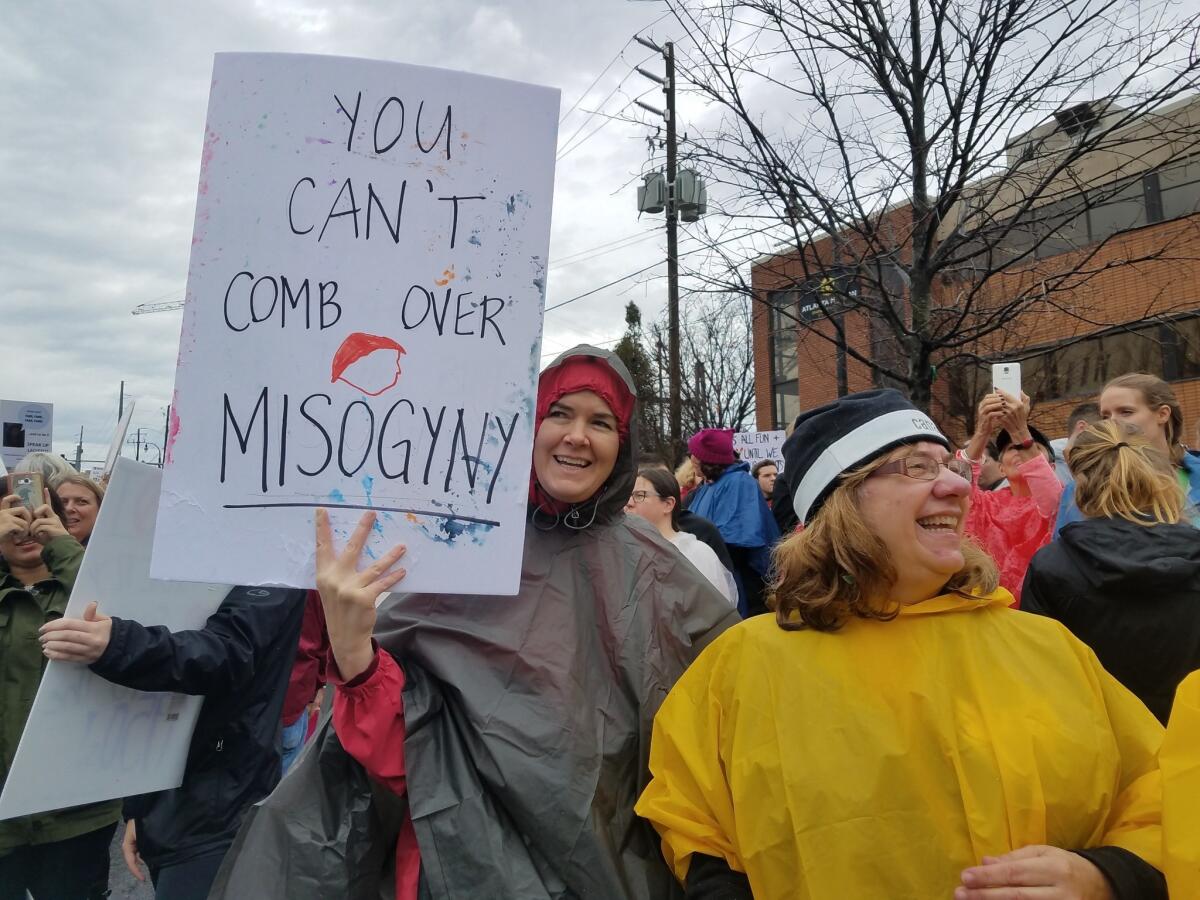
Marie Provence was determined to voice her opposition to Donald Trump’s presidency, so when she woke up Saturday morning to roaring thunderstorms and lightning, she was not put off: “NASTY SOAKING WET WOMAN” she wrote on a large piece of cardboard, carefully wrapping her homemade sign in plastic.
Trump’s inauguration speech really made her angry, the 28-year-old graphic designer said as she stood in a red raincoat in downtown Atlanta. “He sounded like a dictator.”
Tens of thousands of marchers braved torrential rain and tornado warnings to gather outside the Center for Civil and Human Rights in Atlanta’s March for Social Justice and Women. Organizers stressed it was not a protest, but a “display of solidarity.”
U.S. Rep. John Lewis, the Georgia civil rights icon who skipped Friday’s inauguration, kicked off the proceedings.
“We all came to this land in different ships but we’re all in the same boat now,” Lewis told the crowd, to loud whoops and cheers. “Got on your marching shoes? Let’s do it!”
The mood was light, even playful, as the crowd marched past CNN headquarters to the Georgia Capitol, chanting “Love, not hate, will make America great” and waving signs that said such things as, “KEEP YOUR TINY HANDS OFF US” and “YOU CAN’T COMB OVER MISOGYNY.”
Many wrapped their placards and banners in plastic wrap; others displayed them under clear umbrellas and ponchos.
“This is a little bit cathartic,” said Amy Hilton, a 46-year-old management consultant, as she gazed across a sea of multicolored raincoats and banners. “It’s important to voice our dissent and stand against this man who doesn’t represent us.”
- Share via
Who started the march? One woman
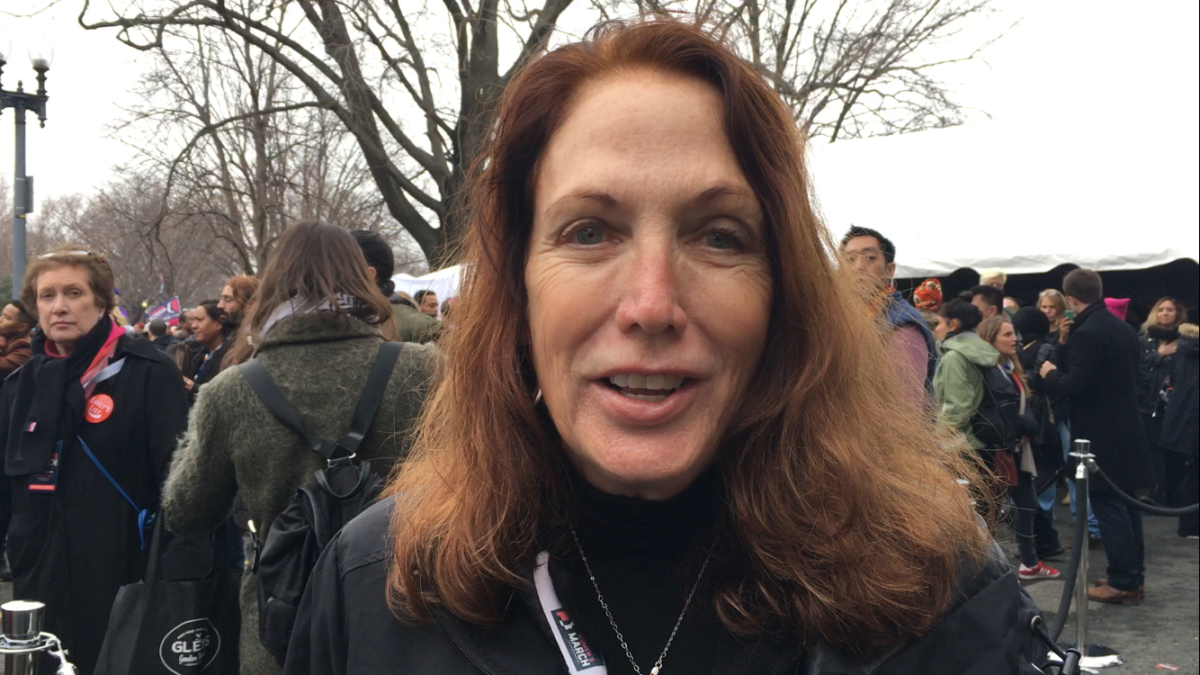
She only had three minutes on stage Saturday to address the hundreds of thousands who lined the Mall in Washington but it was enough to leave Teresa Shook ecstatic.
“I’m overwhelmed with joy. A negative has been turned into a positive. All these people coming together to unite to try and make a difference. That’s what we’re going to be doing for the next four years. I see it’s really going to happen.”
The Women’s March on Washington all started with a Facebook invite. And Shook, a resident of Hawaii who goes by “Maui cooper slim” online, is the women who started it all with the click of a button.
Frustrated by the 2016 election results, Shook invited 40 of her friends to a March on Washington. When she awoke the next morning 10,000 additional names had joined the group and there were 10,000 interested in coming.
Did Shook foresee this all culminating in Saturday’s march? “I hoped but no,” Shook said. “That night I just did it because it made me feel better in the moment. I hoped that people would get on board.”
With a D.C. crowd estimated at 500,000 and more than 600 marches around the country, clearly they did.

Teresa Shook, who helped organize the Women’s March on Washington, shares her reaction to the turnout.
- Share via
Mexico City marchers demand rights for women and migrants
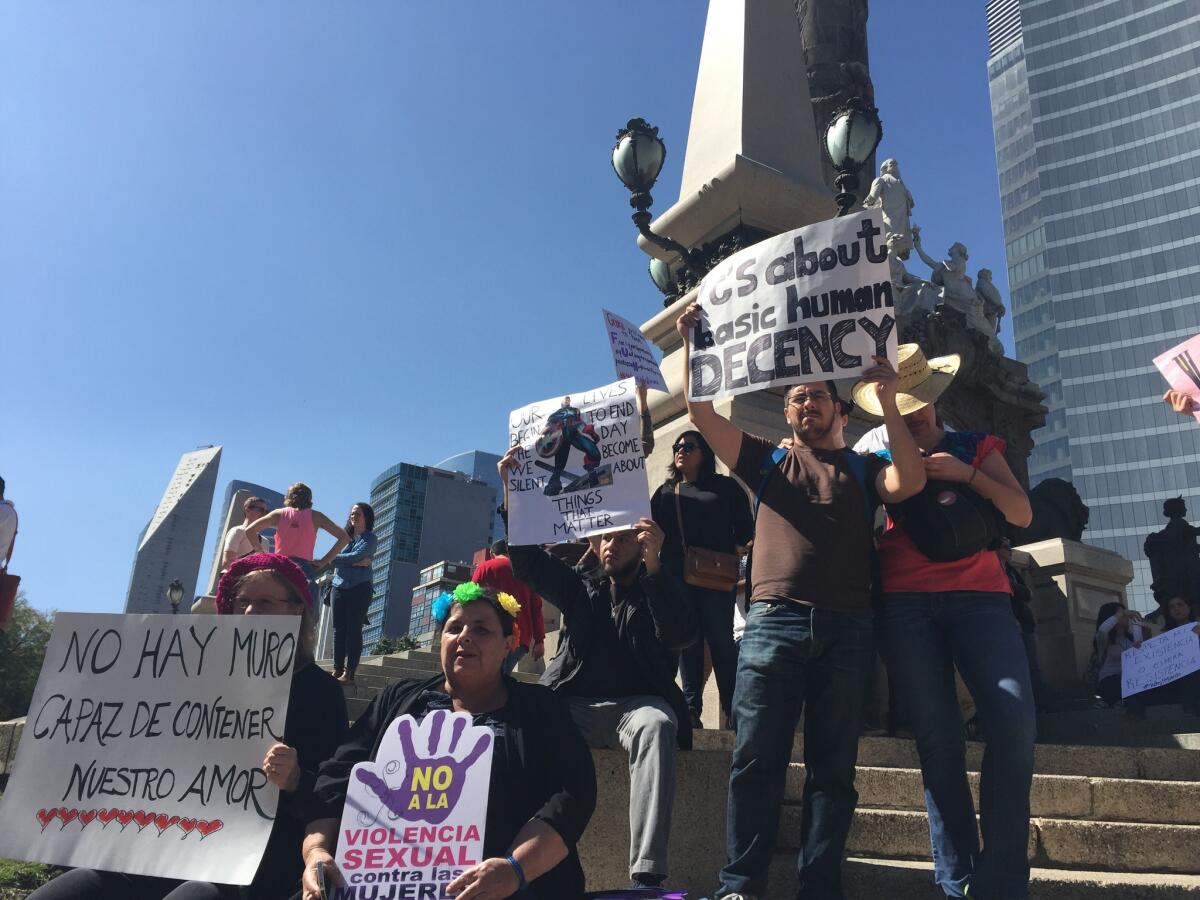
Hundreds of protesters—including women, men and children-- took to the streets of the Mexican capital Saturday to defend women’s rights and assail President Trump.
“We demand an end to the misogyny of Trump, to his discriminatory politics,” said Estela Ruiz, 27, a lawyer who was among the 500 or so who gathered in front on the U.S. Embassy and later at the nearby Angel of Independence monument. “But this is a demand not only for the rights of women, but also of migrants, a shout against his discriminatory, misogynistic and macho ideas.”
During his campaign, Trump often targeted Mexico, threatening to step up deportations of illegal immigrants, build a wall along the U.S.-Mexico border and slap tariffs on Mexican goods exported to the United States.
There is considerable fear that Trump’s prospective policies could trigger an economic meltdown in Mexico, where the economy is heavily dependent on cross-border trade and cash sent home from Mexican nationals residing in the United States. But many march participants focused not on potential economic impacts but rather on what they labeled Trump’s anti-women and anti-migrant agenda.
“Trump should listen loud and clear: We are not going to allow his discriminatory politics,” said Carmela Paredes, 42, a university professor. “We are not going to allow his attacks against women, against gays, against migrants.”
Added Clara Zamora, 21, a student: “If he [Trump] thinks there will be no consequences, he is mistaken: We women are ready and prepared to confront him.”
- Share via
‘I chose “Nasty” ’: A woman’s first protest in Seattle

Andi Buescher participates in the women’s march in Seattle.
Andi Buescher came alone to the women’s march in Seattle, and doing so required some effort.
She woke early at her home in Bremerton, Wash., took the hourlong ferry across Puget Sound, arrived downtown and then walked more than two miles across the city’s steep hills toward Judkins Park, where an advance rally was being held.
“This is the first time I’ve even done something like this,” said Buescher, 35. “But I’m kind of inspired and moved to be a little more involved. I was skeptical about coming alone, but said, [forget] it, I’m going to go. And it’s kind of moving to see everybody coming together for something like this. Everybody’s been really friendly.”
Buescher, who moved to Bremerton from Los Angeles last year, said she supported Bernie Sanders in the California primary in June and voted for Hillary Clinton in November because she was “the lesser of two evils? I don’t know.”
She refused to watch or even read about Donald Trump’s inauguration on Friday.
“Looking at his Cabinet picks, I just don’t see this going a good way,” she said. “I hope I’m wrong. I don’t think I am, but I hope I am.
“I’m here because of my own rights as a woman, including my reproductive rights,” she said, adding that she was particularly frustrated with Republican efforts to cut funding to Planned Parenthood.
“Planned Parenthood is not an abortion factory. It’s the reason I never had abortions in the first place. And I want equal rights for everybody — every race, every gender — just rights.”
Buescher came empty-handed, other than carrying a camera. But by the time she arrived at the march, she had a simple sign with one work taped to the back of her yellow raincoat: “NASTY.”
“I didn’t have any sign, and I don’t own anything pink. Someone on the ferry was handing out signs. And they had ‘Nasty,’ ‘The future is female,’ ‘Women’s rights are human rights,’ and I chose ‘Nasty.’ ”
- Share via
This is possibly the cutest view of the Los Angeles women’s march
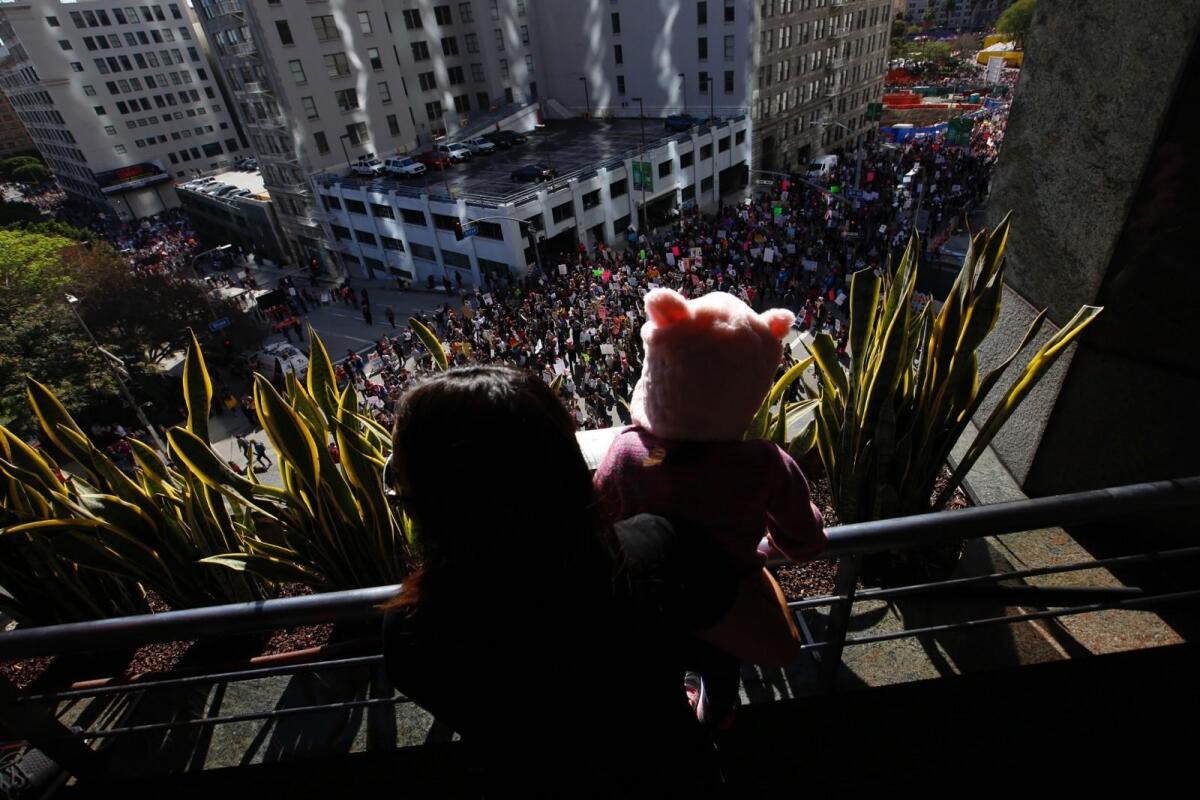
Gina Corpus, and her daughter Camila Corpus, 2, watch the march.
- Share via
‘Carrie Fisher sent me’: These are the signs people brought with them to the women’s march in Washington

Signs at the Women’s March on Washington
- Share via
Police: Downtown L.A. march appears to draw largest crowd since 2006 immigration protest
Authorities are still working on a crowd estimate for the women’s march, but officials said it appears to be the largest since the famous 2006 immigrant-rights protest in downtown L.A.
The Los Angeles Police Department estimated that march to have drawn 500,000 people, but organizers insisted the number was higher.
“There is a sea of humanity everywhere,” Los Angeles police Capt. Andrew Neiman said of the women’s march.
- Share via
‘It’s ours to change’: Uzo Aduba with ‘What Meryl said’ sign appears at Women’s March on Washington
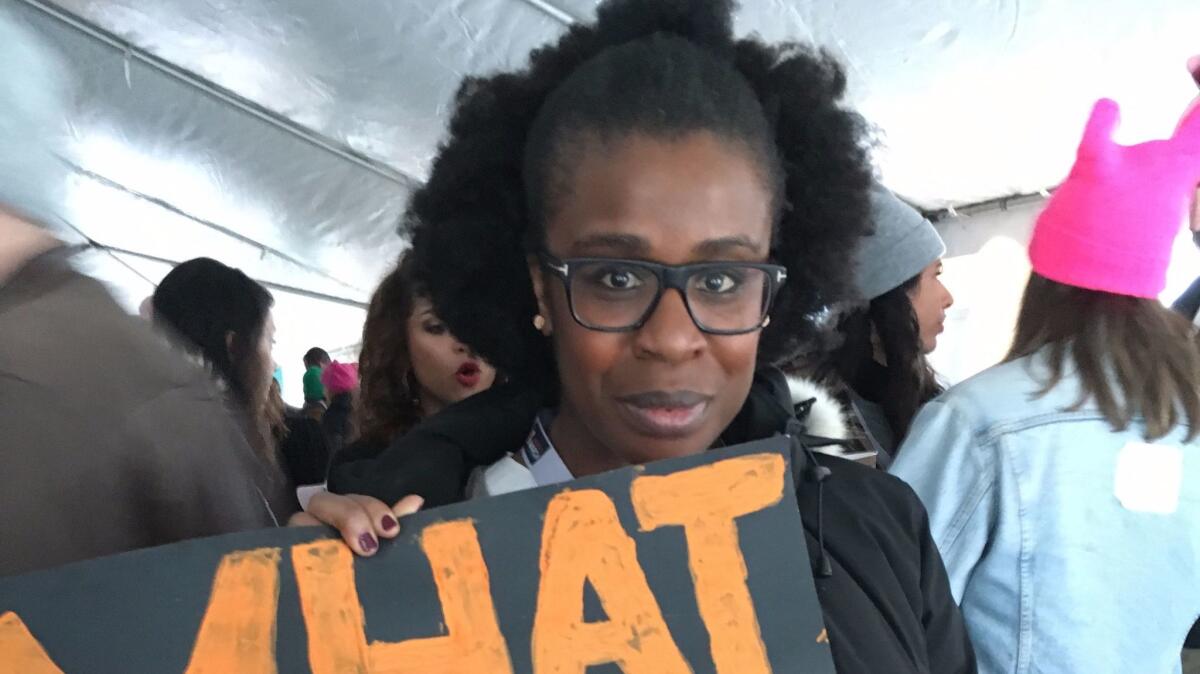
Actress Uzo Aduba was at the Women’s March on Washington on Saturday holding a sign that read, “What Meryl said.”
The reference, of course, was to Meryl Streep’s provocative acceptance speech for lifetime achievement at the Golden Globe awards. We stopped Aduba and asked, “How are you as an artist going to reflect the change you want to see in America?”
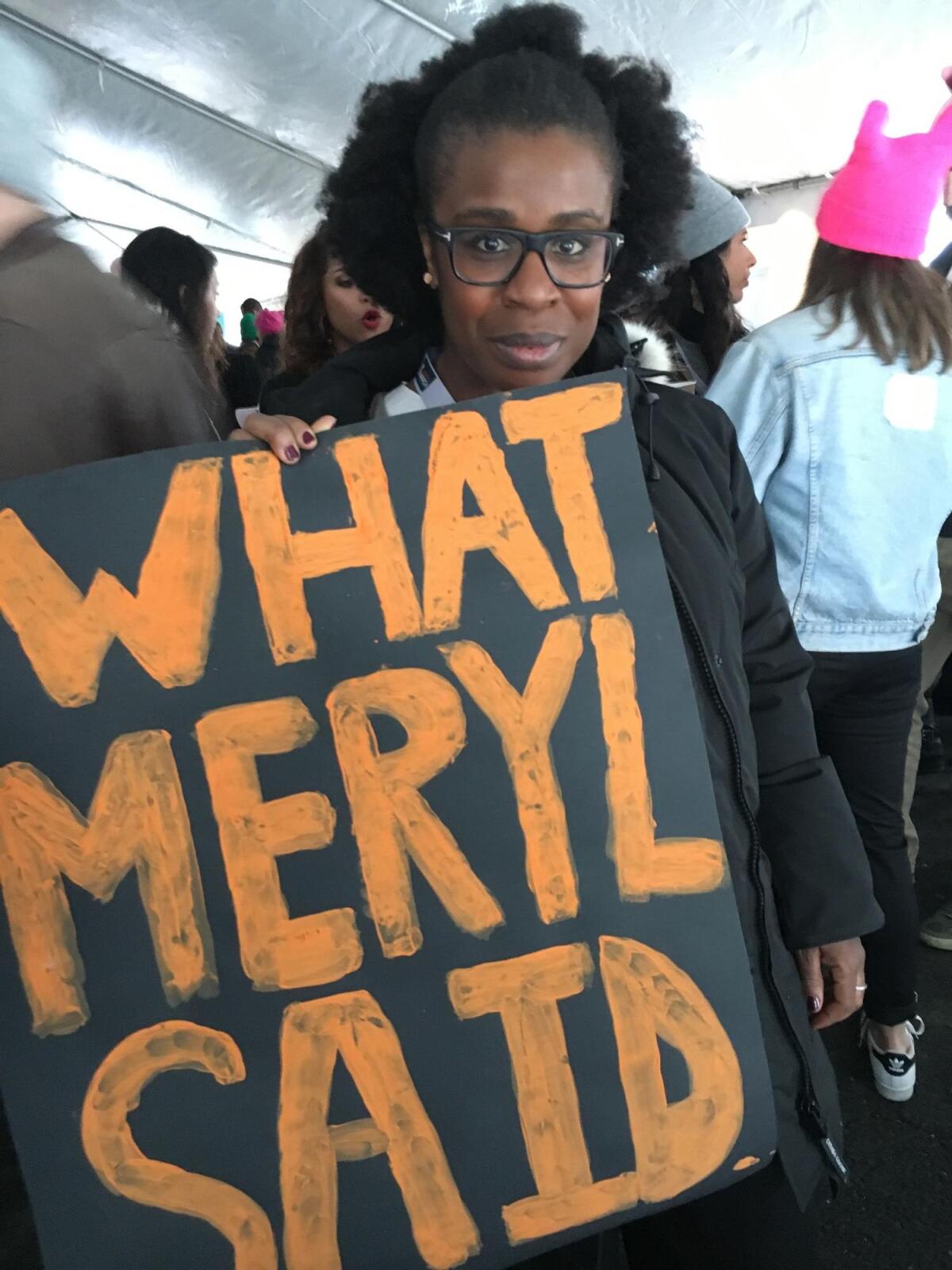
“Its taking action,” she said. “The best example would be the Obamas. The most progressive and aggressive thing, I think, [was] taking their public position and taking it to the private sector so quickly and effectively with the Obama Foundation.
“He was so smart to realize that he has activated an entire group of people, like myself when I first became a donor when I had no money whatsoever. And realizing the power that we each have as individuals to be activated on a daily basis.
“It’s ours to change. We actually don’t necessarily need to have massive coalitions, massive groups or bodies of government. We the people are able to advance and make change. So I want to live my change daily.”
- Share via
Marchers in Germany have a message: Trump, sir, is no Berliner
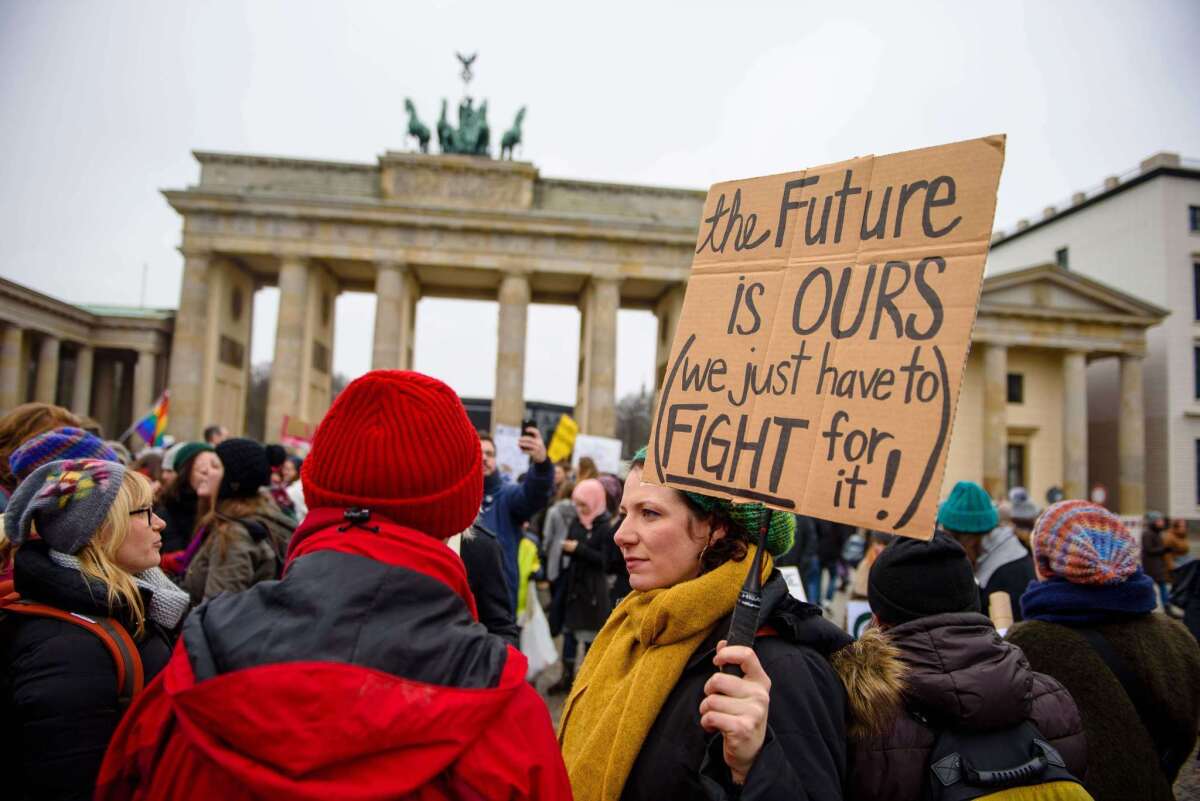
In Berlin, about 1,000 women demonstrated for about an hour on a chilly Saturday afternoon in front of the U.S. Embassy in the heart of Berlin, next to the Brandenburg Gate. There were smaller rallies in Munich and Frankfurt.
Many in the crowd in Berlin, the country’s capital and largest city, were Americans living in the city.
“No hate, no fear,” they chanted at the rally, held in solidarity with the march in Washington. “We are unstoppable, a better world is possible.”
One woman was holding a sign that read: “Trump ist kein Berliner,” (Trump is not a Berliner) — a reference to John F. Kennedy’s 1963 “Ich bin ein Berliner” speech of solidarity for West Berlin.
Many Germans and others living in Berlin are particularly worried about what they believe is a growing threat of global tensions with Donald Trump as president. Because of its belligerent 20th century past and the destruction caused by World War II, many Germans are especially attuned to any early indications of international friction.
“Make America Afraid Again” read the slogan on one poster that featured a picture of Trump and mocked his “Make America Great Again” rallying cry.
Other signs read “Nope” with a picture of Trump’s face that was similar to the “Yes, we can” posters hoisted during former U.S. President Barack Obama’s campaign. There were other signs with messages reading “No to sexism,” ’’Women’s rights are human rights” and “Our bodies, our minds, our power.”
- Share via
Amy Schumer, Madonna, W.H. Auden and f-bombs on the Mall in Washington
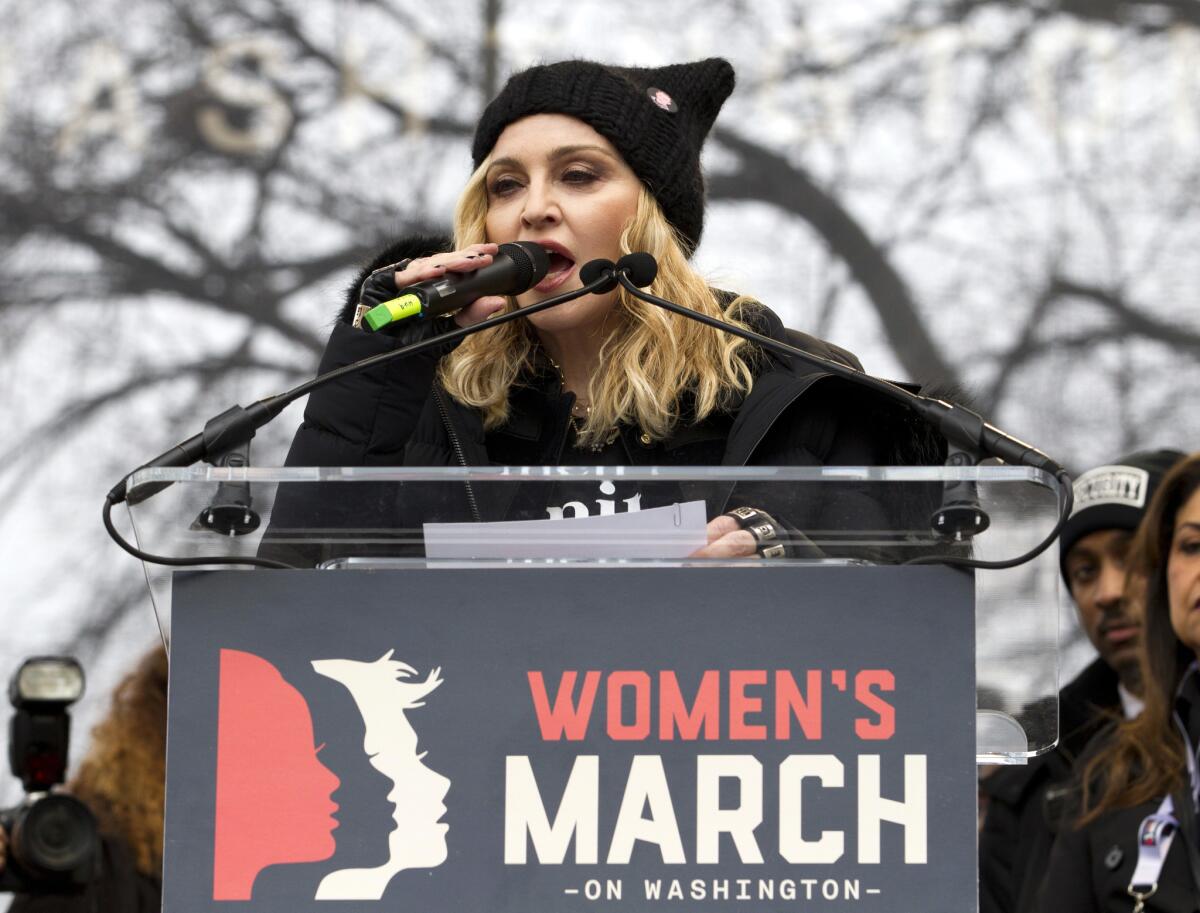
Around hour six, the crowds lining the Mall in Washington needed a little pick-me-up, which they got when Amy Schumer took the stage, albeit briefly. While fans screamed, Schumer expressed her pride in being at the march and then proceeded to introduce the next celebrity guest.
“Ladies and ladies,” she said. “Madonna!”
Indeed it was she, wearing a black version of the march’s signature “pussyhat,” calling for a “revolution of love” and dressing down anyone unimpressed by the event.
“To the detractors who say this march will not add up to anything,” she had a staccato repetition of signature obscenity that sent CNN and MSNBC into sudden cuts and apologetic damage control. (C-SPAN, on the other hand, was not bothered.)
F-bombs weren’t the only sort of explosive statements on the star’s mind. She admitted that she had had thoughts of “blowing up the White House” before realizing “that won’t change anything.”
Switching gears, or maybe not, she quoted W.H. Auden: “We must love one another or die.”
Then, of course, she sang “Express Yourself.”
- Share via
Canadian man wears heels to downtown L.A. women’s march to ‘walk a mile in her shoes’
Dean Heezen was in town from Canada for work and decided to buy a pair of red heels to wear during the women’s march.
Along the route, the 26-year-old clutched a sign that read: “Walk a mile in her shoes.”
“Power to you for walking in heels,” one woman told him.
“Power to you for wearing them,” he replied.
“I don’t know how women do it,” Heezen added. “But if they can walk in them everyday, then I can walk in them for a little bit.”
- Share via
California marcher: ‘I wanted to use my white-straight-Christian woman privilege’ to help vulnerable voices be heard
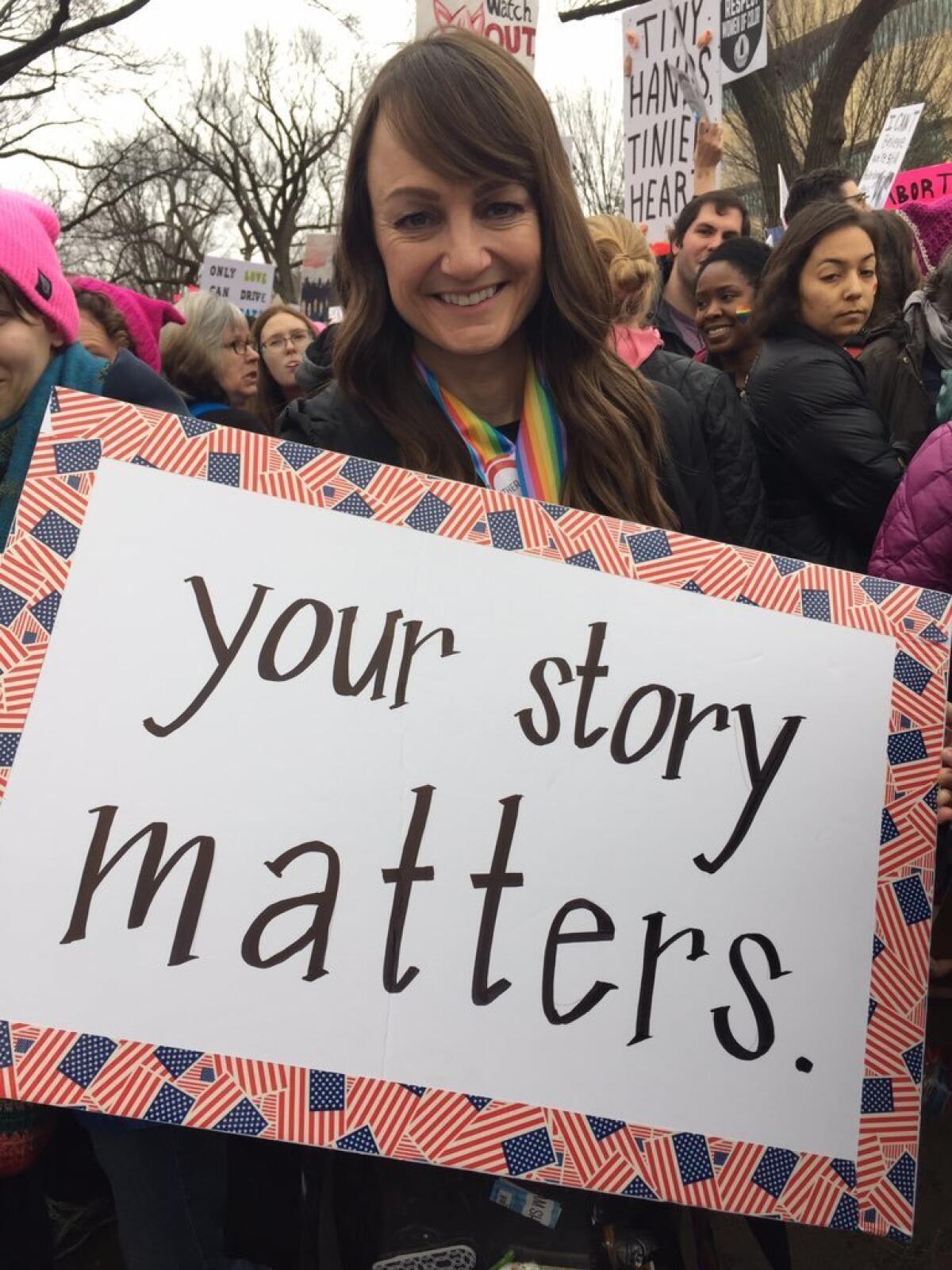
Desta Goehner, 40, of Thousand Oaks, said she made the trek from California to the Women’s March in Washington, D.C., because she wanted to be there with her best friends — and to stand up for her daughter and anyone who is vulnerable.
“I wanted to use my white-straight-Christian woman privilege to stand here to help other voices that are vulnerable be heard,” Goehner said.
Virginia Matzek, 47, an environmental scientist from Davis who described herself as a liberal, brought along her two sons, 14 and 16. They attended President Trump’s inauguration on Friday to see the turnout, and noted that it appeared small.
“The crowd was puny,” said Matzek, a professor at Santa Clara University. “I hope [Trump] knows his ratings are poor.”
Matzek said she has been unhappy when Republicans won the White House in the past, but she never felt fear as she did after Trump’s victory.
“In the past, I at least believed the opposition party would obey the norms of democracy. I thought they were good people who I disagreed with on policy,” she said. “In Trump, we elected a proto-fascist. He is not a good person. He is not fit for office. He is not fit for humanity.”
Michelle Pierson of Van Nuys and Nicole Myers of Woodland Hills decided they had to participate in the Women’s March the day after the election. Their husbands took off work to care for their children so the two women could spend the week protesting in the nation’s capital.
“We had to do something to deal with our frustration, our sadness, our rage,” said Pierson, 38, a stay-at-home mom.
Myers, 40, owns a picture-framing shop. She said she was thinking of her 10-year-old son at the march.
“I don’t want him to think someone could speak like that and be president.”
- Share via
See the massive crowd gathering at Los Angeles City Hall
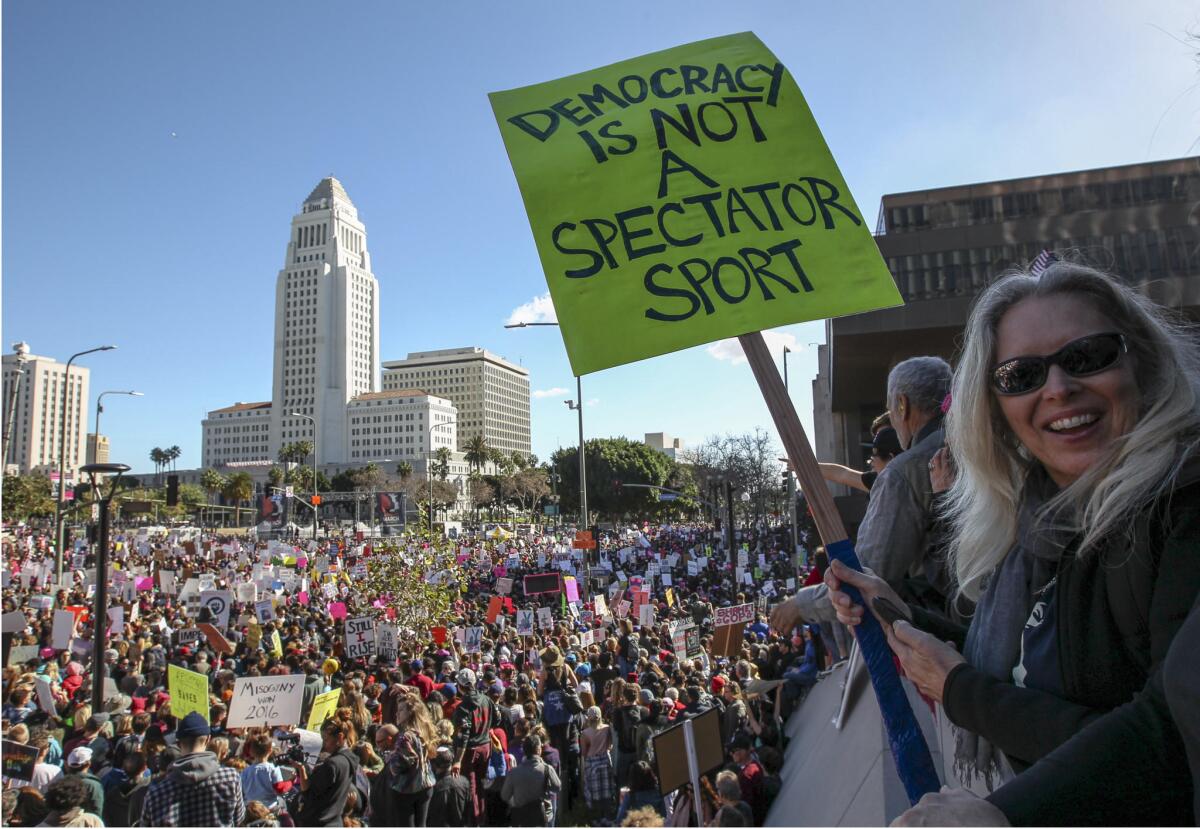
- Share via
Tens of thousands march in Sacramento: ‘This is one of the most important moments for our democracy’
The crowd for the women’s march in Sacramento swelled to nearly 30,000 participants, according to one police officer, and they carried colorful signs and chanted, “Fired up. Ready to go.”
Laura Gibson and her 17-year-old daughter, Lydia, wore bright pink, cat-eared hats with a group of other mothers and daughters. They drove in from Redding “because we couldn’t sit still,” said Laura Gibson, 44.
After marching from Southside Park to the Capitol grounds, Sue Martens, 63, said she was excited to see so many young people taking to the streets. She protested in the Vietnam era and found it necessary to protest today, she said.
“This is one of the most important moments for our democracy,” she said.
Sally Dunn, 64, a homeless advocate from Fresno, passed out copies of a community newspaper. She said she came to the Capitol to demand equal access to housing and healthcare. The issues are huge for her, she said, because she has a daughter with lupus and is supporting another who has breast cancer.
“The struggle is real,” she said. “You have to fight for what you want. We have to stand up now or forever hold our peace.”
- Share via
Are you marching? Tell us why
“Because there are still too many people who want to pull us back, and I want to move forward,” Janey Wong, who’s marching in Portland, Ore., wrote us.
Tell us why you’re marching, and read what other people are saying.
- Share via
Three generations of women march proudly in Washington’s ‘beautiful scene of positivity’
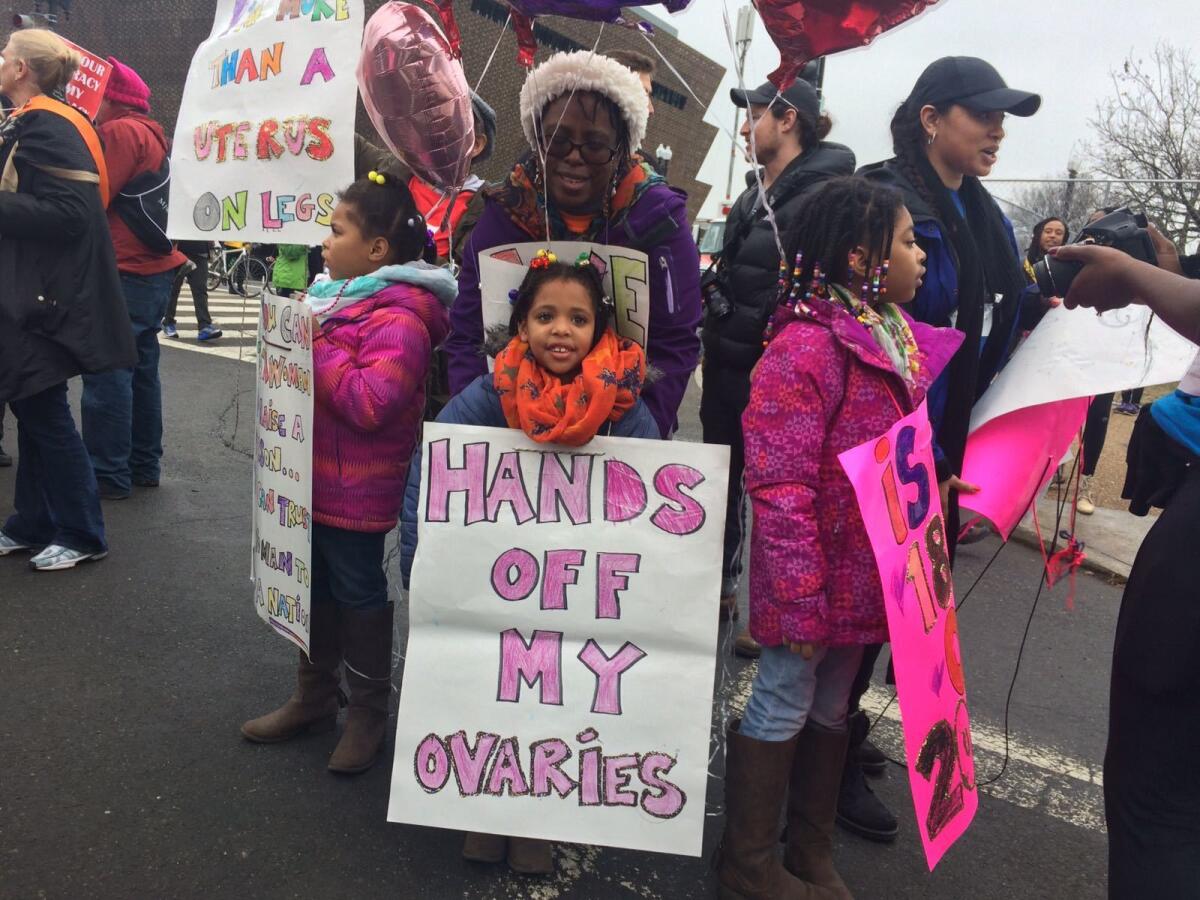
The marchers flooding Constitution Avenue seemed to represent the vast expanse of modern America: women and men, white and black, Christian and Muslim, young and old.
One small group included three generations of women and girls from the same family, marching together while proudly clutching colorful signs.
Jessica Parker Coleman, 56, holding a sign that said, “Save the middle class,” had decided to come up from Georgia to join the march with her daughter, Amber Coleman-Mortley, 34, and Amber’s daughters, Naima, 7, Sofia, 5, and Garvey, 8.
“When I heard about this one, I wanted to come right away,” Parker Coleman said, adding, “we need positivity back in our country.” And what she beheld as marchers peacefully streamed past her family, she said, was “a beautiful scene of positivity.”
For Coleman-Mortley, who lives in Washington, D.C., the march was a teachable moment for her own daughters.
“I want my kids to see that peaceful protest, and that peaceful dissent, is OK,” Coleman-Mortley said. It was also personal. “Being a black woman, I’m at the place where race and gender issues are my problem. It’s just important for me to come out here to address that — ‘Hey, I matter.’ ”
Before she continued marching, she held up her sign: “435 House seats, 33 Senate seats, 36 governorships. Don’t like it? Vote 2018.”
- Share via
Cory Booker: Women’s march is ‘not a Republican or Democrat thing. This is something we can all unify around’

Sen. Cory Booker interview at Women’s March on Washington
New Jersey Sen. Cory Booker believes the women’s march represents bipartisan issues.
“This is about responding to misogyny, bigotry, racism — all of those things that are undermining who we are,” he said in Washington, D.C.
“This is not a Democrat or Republican thing. This is actually something we can all unify around.”
- Share via
Tens of thousands are marching in Texas
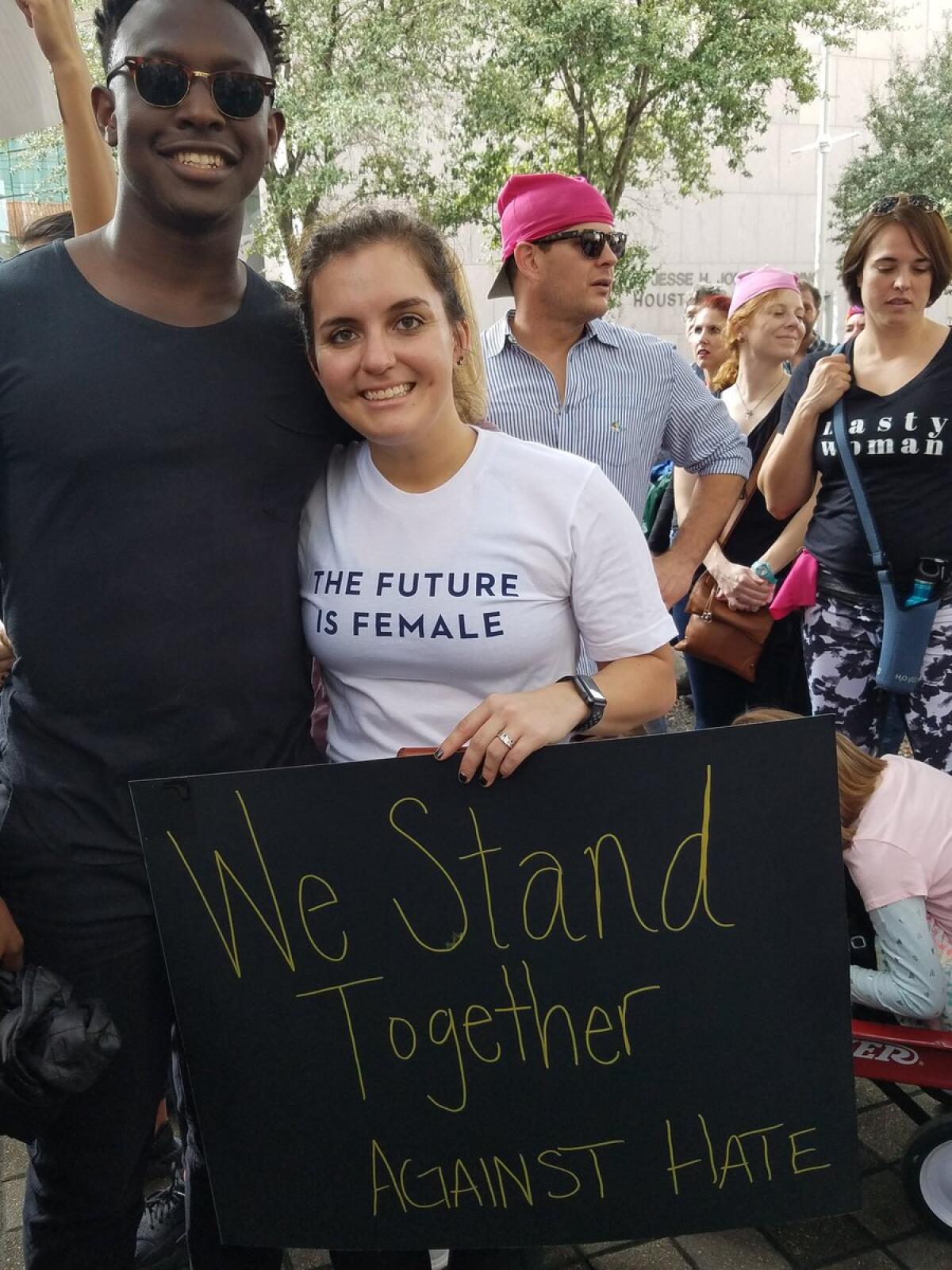
In Houston, police estimated the crowd for the women’s march had swelled to 20,000 people, much larger than expected.
As many as 30,000 were marching in Austin, blocking a major intersection.
Abdul and Danielle Sule, 25 and 26, respectively, attended the march with relatives. They worried what a Trump presidency would mean for them.
It’s not so much about attacking a person or what happened this past election so much as about protecting minority groups.
— Abdul Sule, Houston resident
- Share via
Kamala Harris: The women’s march is ‘absolutely personal to me’

Sen. Kamala Harris interview at Women’s March on Washington
Sen. Kamala Harris (D-California) was “walking on a cloud” after speaking to thousands at the women’s march in Washington.
Her message: All issues are women’s issues.
“We will not retreat when being attacked. We will stand up and we will fight.”
California’s newest Democratic senator reflected on Trump’s inauguration speech just the day before, calling it a “dark” message for Americans.
“I am concerned that we are on a path to appeal to our lesser instincts instead of our better selves,” she said.
She went on to echo something Trump emphasized in his inauguration speech: The people have the power.
“There are thousands and thousands of people here today. And I think everyone should take note, that this is a very powerful voice – they’re activated and they must be taken seriously.”
The senator spent about 45 minutes backstage greeting people before her speech. Along the way she said she ran into someone who was best friends with her mother when they were students at UC Berkeley during the civil rights movement of the 1960s.
“This is absolutely personal to me. This is absolutely personal to me.”
Women traveled from all over the country to be at the D.C. march, including many from California. To them, and all Californians who were hoping for a different outcome, she paraphrased Coretta Scott King.
“The fight for civil rights will be fought and won with each generation. Whatever gains we make will not be permanent,” she said. “That’s the nature of it, so let’s not be dispirited.… Let’s just get up, pick ourselves up and get out there and fight. Fight for equality, fight for fairness, fight for justice.”
- Share via
Houston mayor: ‘In this city, we are going to love one another’
In this city, we are all in it together. I don’t want people in this city walking around thinking they’re going to be divided, sent back. In this city, we’re not going to do that. In this city, we are going to love one another.
— Houston Mayor Sylvester Turner, a Democrat, at a rally in front of city hall that followed the march there
- Share via
Scarlett Johansson to Donald Trump: ‘I didn’t vote for you. But I want to be able to support you’
Speaking before hundreds of thousands gathered on the National Mall for the Women’s March on Washington, Scarlett Johansson addressed President Trump in his own terms -- the art of the deal.
She would support him if he would support her, her daughter, her family and all American women.
Declaring that it was time for even a private person like herself to get personal, Johansson delivered a passionate speech about the role Planned Parenthood has played in her life from her first visit at the age of 15. She called on the president to stop continued attempts to withdraw federal funding for the organization and offered an early olive branch to Trump, who has been inconsistent about his intentions.
“I didn’t vote for you. But I want to be able to support you. But first I ask that you support me,” she said, adding that she wanted her daughter to grow up with the same access to health resources that Trump’s daughter Ivanka had during her youth and young adulthood.
- Share via
Follow L.A. Times reporters at women’s marches throughout the world
- Share via
In Phoenix, protesters blame Trump for divisiveness
With an American flag hanging off her back and a large black circular sticker that read “Impeach!” Penny Shaw did not arrive at the protest rally in downtown Phoenix in a conciliatory mood.
“Our voting rights, our bodies, our water -- it’s all at risk, today,” said Shaw, 54, of Scottsdale. “You’ll find lots of reasons for people to be marching. All of it should scare us.”
More than 20,000 people found sunny and cool conditions in Phoenix for Saturday’s march, one of dozens of demonstrations around the country protesting the election of Donald Trump. Protesters blamed Trump for inciting a tone of national divisiveness.
Among the causes represented on signs on Saturday were LGBTQ rights, abortion rights, opposition to the Dakota Access pipeline, restoration of the Voting Rights Act and a litany of individual protests against comments Trump has made about members of minority communities, women and the disabled.
“In my 87 years, I’ve never felt such disunity,” said Toni Portnoy. “We need to be the America that was, not the America that’s going to be.”
- Share via
Watch Miley Cyrus shimmy her way through downtown L.A. women’s march
Organizers released a long list of Hollywood heavyweights scheduled to attend Saturday’s march, including Natalie Portman, Kerry Washington and Barbra Streisand.
- Share via
Tens of thousands at Sacramento women’s march
- Share via
Trains were too packed for these women to board, so they hitchhiked to downtown L.A.
Some protesters hatched transportation plans that went smoothly, while others were thwarted by crowds at train stations that turned the trip downtown into an epic journey.
The Grashaws — three cousins and a mother — waited for two hours at the North Hollywood Red Line station before trying to hail an Uber.
The app kept canceling on them. So the four women hitchhiked, begging a random driver to take them downtown. They gave him $60 to drop them off on the other side of the 110 Freeway, at Beaudry and 4th, said Ashley Grashaw, 32.
One of the Grashaws held a sign that said “Trump = SOOOO unpopular — SAD!” which played on Trump’s favored diction. The other women held cardboard torches, one that said “freedom,” another “love” and the third “truth.”
- Share via
Here’s an aerial view of the downtown L.A. women’s march
- Share via
Why are people marching today? It’s personal
“Women’s rights aren’t up for grabs, and neither are we,” Los Angeles women’s march participant Jaime Hunt wrote us.
There’s no single reason hundreds of thousands are marching across the country. Some are marching for equality, some for sisterhood, some for daughters and some for mothers. Are you marching? Tell us why.
- Share via
One protester’s message to Trump: ‘Tweet some hope is all I want, dude’
Brenda Tullo stayed up late crocheting a hat for her daughter, Allison, then rose before the sun came up to drive to downtown Los Angeles from San Bernardino.
“I’m doing this for the women who came before me, who gave me the privilege to do everything I do today,” said Allison Tullo, 24, who works at a coffee shop. Her aunt and grandmother went to a different Women’s March in Ventura.
President Trump has insulted just about everyone who isn’t a white man, she added, holding a pink sign that said “Pussy Power.”
Brenda Tullo, 56, a food and beverage manager, expressed outrage at Trump’s attitude about grabbing women’s private parts.
“I am a nasty woman,” she said, referencing an insult Trump directed at his Democratic opponent, Hillary Clinton, during a presidential debate. Her pink sign read, “Nasty women unite.”
Many of the handmade signs carried by protesters referred to women’s rights, including abortion rights. Some were directed at Trump.
“Trump, putting the bully into the pulpit,” read one sign. “Keep your tiny hands off our rights,” read another.
Others sought to turn the conversation in a positive direction: “Tweet Love, Tweet Peace,” read the sign carried by Andrea Testa, 52, a realtor from Long Beach.
“Tweet some hope is all I want, dude,” she said.
- Share via
Protesters in Mexico City chant: ‘No KKK, no racist U.S.A.’
In Mexico City, several hundred people gathered Saturday outside the U.S. Embassy in protest.
The demonstration was designed to send a message to Washington, but also to Mexicans, said one of the organizers, Indiana-native Hannah Kurowski, 25.
“Our presence here is important to show that Americans are not all like Trump,” said Kurowski, who has worked in Mexico City for the last two years.
“The night of the election, I felt really alone,” she said. “I called my mom crying and said, ‘I have to go home to help fight this.’
“My mom told me to stay. She said: ‘Be an ambassador for your country, and represent tolerance and love and diversity.’ ”
Kurowski carried a sign addressed to the new U.S. president and House Speaker Paul Ryan. “Do not touch Obamacare or Planned Parenthood,” it said. “We are around the world.” The phrase “Women’s March” was scrawled across her arms and chest.
“It’s important that people who have been attacked are leading this movement,” she said. “I think that what’s come out of this is a new civil rights movement.”
“This is good to see,” Janet Leder remarked to her husband, Steve Silverman.
A 66-year-old retiree from Chicago vacationing in Mexico for several months, Leder said she and her husband would have been in Washington for the march if they were in the U.S. They are veterans of the civil rights movement and the anti-war protests of the 1960s.
“He’s a terrible, terrible, terrible sociopath and con man,” said Leder, a former therapist. “I think he’s really disturbed.
“We are distraught,” she said. “We’re hoping the impeachment comes soon.”
- Share via
Huge crowd begins to move at Women’s March on Washington
- Share via
Women’s March co-chair: ‘I will respect this presidency, but I will not respect the president.’
I will respect this presidency, but I will not respect this president.
— Linda Sarsour, activist and co-chair of the Women’s March on Washington
- Share via
A march around the globe: Women’s protests unfurl in Europe, Australia, Africa
It wasn’t just Washington. In fact, it wasn’t just America. As thousands of American women took to the streets across the U.S. in the wake of the election of Donald Trump as president, similar marches were happening around the world--a demonstration of what participants said was global solidarity.
Cities where protests were held included Sydney, Australia; Cape Town, South Africa; Nairobi, Kenya; Budapest, Hungary; Rome; and London, bringing tens of thousands into the streets to stand up for women’s rights and civil liberties, which many fear are now under threat with Trump in the White House.
“Girl Power vs Trump Tower,” read a sign held aloft in Sydney as the crowd chanted: “When women’s rights are under attack, what do we do, stand up, fight back.”
In Cape Town, the march passed the city’s parliament and there was a multitude of slogans including: “So over mediocre men running things” and “It’s time for women to stop being politely angry.”
There were a total of 673 “sister” marches taking place around the world Saturday in addition to the main rally in the U.S. capital, according to womensmarch.com.
The group estimated that more than 2.5 million people had participated globally.
Organizers said the aim was for women -- but also men and children -- to come together and stand up for the world’s vibrant and diverse communities after the most bitter election campaign in U.S. history.
- Share via
Jubilant protesters crowd into downtown L.A.-bound Metro trains
Metro trains were jammed to capacity Saturday morning as tens of thousands descended on Pershing Square in downtown L.A. for the women’s march.
Erica Zeitlin said she caught the Expo Line in Santa Monica but it took nearly an hour before there was a train available with enough space to accommodate passengers.
“Metro could have put on 10 times as many trains and they’d be busy,” she said. “The platforms are packed.”
They were so packed that some Culver City passengers said they had to travel west to Santa Monica before they were able to board a downtown-bound train.
Passenger Angela Duffy said the Culver City station was so packed she decided to walk to the Palms Station. But that station was also crowded, so her group headed to the Santa Monica station.
“It is worth doing it to stand with my fellow women in solidarity,” Duffy said. “Change needs to happen … if I just sat at home because I didn’t want to get into the crowds, I would not be standing up for what I believe in.”
“Ready, happy, thrilled!” yelled the jubilant crowd.
- Share via
Hear women’s march participants talk about why they went

Morning after inauguration, thousands gather for Women’s March in Washington
- Share via
Washington Metro ridership skyrockets on day of march

Washington Metro ridership was at 275,000 before noon Saturday. In case you’re wondering, that’s 40% higher than the 11 a.m. ridership count for Friday, the day Donald Trump was inaugurated as the 45th president of the U.S.
At one point, Metro trains bypassed L’Enfant Plaza station because of crowding.
More than 200,000 people were expected to turn out for the Women’s March on Washington on Saturday in the nation’s capital, with thousands of others joining in solidarity across the globe.
- Share via
This 14-year-old is marching for ‘more women in the House and Senate’
Teenagers and kids were among the thousands of protesters gathered for the women’s march at Pershing Square.
The throngs of people included the Miller family from North Hollywood.
Wearing a New York Yankees hat, Andy Miller, 55, took the Metro line with his two daughters. The crowded trip on the subway, he said, felt like a New York City experience.
Savannah Miller, 14, and Jessie Miller, 12, said they regularly read news sites like BuzzFeed and listen to the radio.
Savannah said she was marching because she wants the world to be “safer for girls.”
“Donald Trump has to make sure to be careful,” she said. “A lot of people aren’t happy.
“I want more women in the House and Senate,” she added.
The large crowd, Jessie said, shows what women can do when they gather.
- Share via
‘You have the power’: California Sen. Kamala Harris strikes defiant tone at Women’s March on Washington
California Sen. Kamala Harris, who was among dozens of speakers at the packed Women’s March on Washington, struck a defiant tone in her words to the sea of people dotted with pink hats.
“When I look at this incredible crowd today I know one thing ... even if are not sitting in the White House ... even if you don’t run a corporate super PAC ... you have the power and we the people have the power,” she said.
Consistent with the theme of other speeches at the event, Harris emphasized that all issues are women’s issues.
“We are tired as women of being relegated to simply being thought of as a particular constituency or demographic,” she said.
California’s newest Democratic senator, sworn in less than three weeks ago, acknowledged that a difficult road lay ahead for the issues important to the marchers, but she was also optimistic.
“It’s going to be harder before it gets easier. I know we will rise to the challenge and I know we will keep fighting no matter what,” she said. “This was a day for us all to come together in our nation’s capital ... let’s buckle in because it’s going to be a bumpy ride.”
- Share via
See images of Los Angeles’ women’s march ahead of its official start
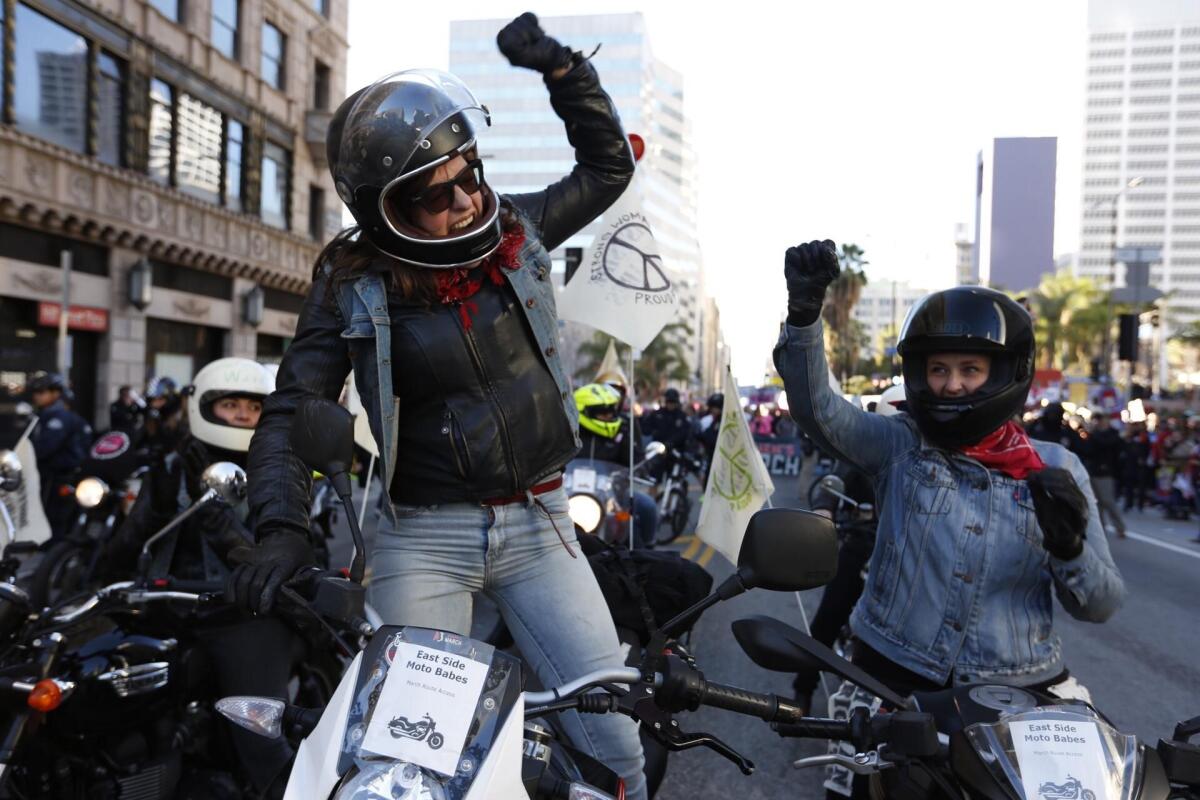
East Side Babes ride in the Los Angeles march. More photos from Los Angeles.
- Share via
White vs. black? Not at today’s women’s march in New York
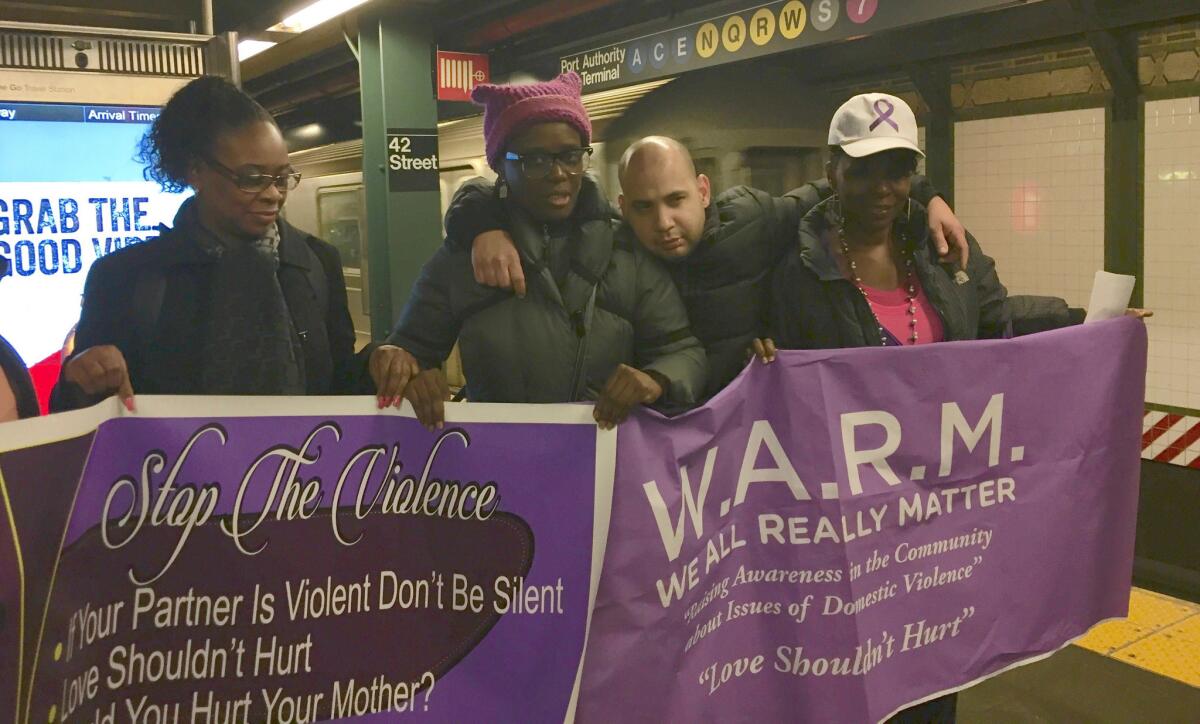
A group of women from New York’s Harlem neighborhood said that rifts between white marchers and women of color have been overblown by the media.
“I might talk more about keeping people from being evicted from their homes, and maybe you want to talk about saving the whales, but on most issues we come together, ’’ said Cordell Cleare, a Democratic Party district leader. “Equal pay affects all women. Domestic violence affects all women.”
“Men, too,” she said with a laugh as a white man photo-bombed a picture that a reporter was taking by draping his arms around two black women.
The women were changing subways at Times Square, crowded Saturday morning with people on their way to the women’s march. Many were men, which Cleare said was a good thing. “We need all the help we can get.”
- Share via
Only in L.A.: Fashion shoot spotted at downtown L.A. women’s march
- Share via
Rights for Latinos, gays and transgender individuals are among the reasons thousands are marching in Houston

Many who marched in Houston came with particular concerns after years of battles here: for women’s health care, along with reproductive, Latino, gay and transgender rights.
They brought handmade signs saying “Leave Planned Parenthood alone,” “Bathrooms for everyone” and “We want healthcare, sex ed and special education.”
“If I lived in the middle of a liberal county, I wouldn’t be aware of how bad it is,” said Allison Anderson, 19, a student who lives in a conservative area outside Houston where she has fought for gay and lesbian rights.
“It’s a lot easier to see how important it is because I have witnessed all the bullying,” she said.
Houston police say at least 6,000 people have arrived for the women’s march; organizers say the number has reached 20,000.
Melanie Beach, who accompanied Anderson and her mother, said she also has witnessed a lot of bullying since the election by Trump supporters who seem to be emboldened by the election outcome to attack minorities.
“I have witnessed kids telling other kids, ‘You’re going to be deported,’ ” Beach said.
In those instances, she said, she took the victim aside and offered reassurances. Then she questioned the child who had made the remark, who ultimately said he was repeating what he’d heard Donald Trump say on television.
“It’s making bullying OK,” she said.
Norma Smith, 74, a retired secretary, brought a sign supporting Planned Parenthood and opposing measures that would restrict transgender access to bathrooms.
She noted that many Planned Parenthood clinics have been forced to close in recent years due to state laws the Obama administration fought.
“It’s a very big concern for the poor women who have to travel miles and miles to get abortions or birth control,” she said. “There’s always hope. There’s a majority of women, if we can get them to speak up.”
- Share via
Women’s march is an intergenerational affair: ‘I feel like this is the first time our generation has felt struggle’
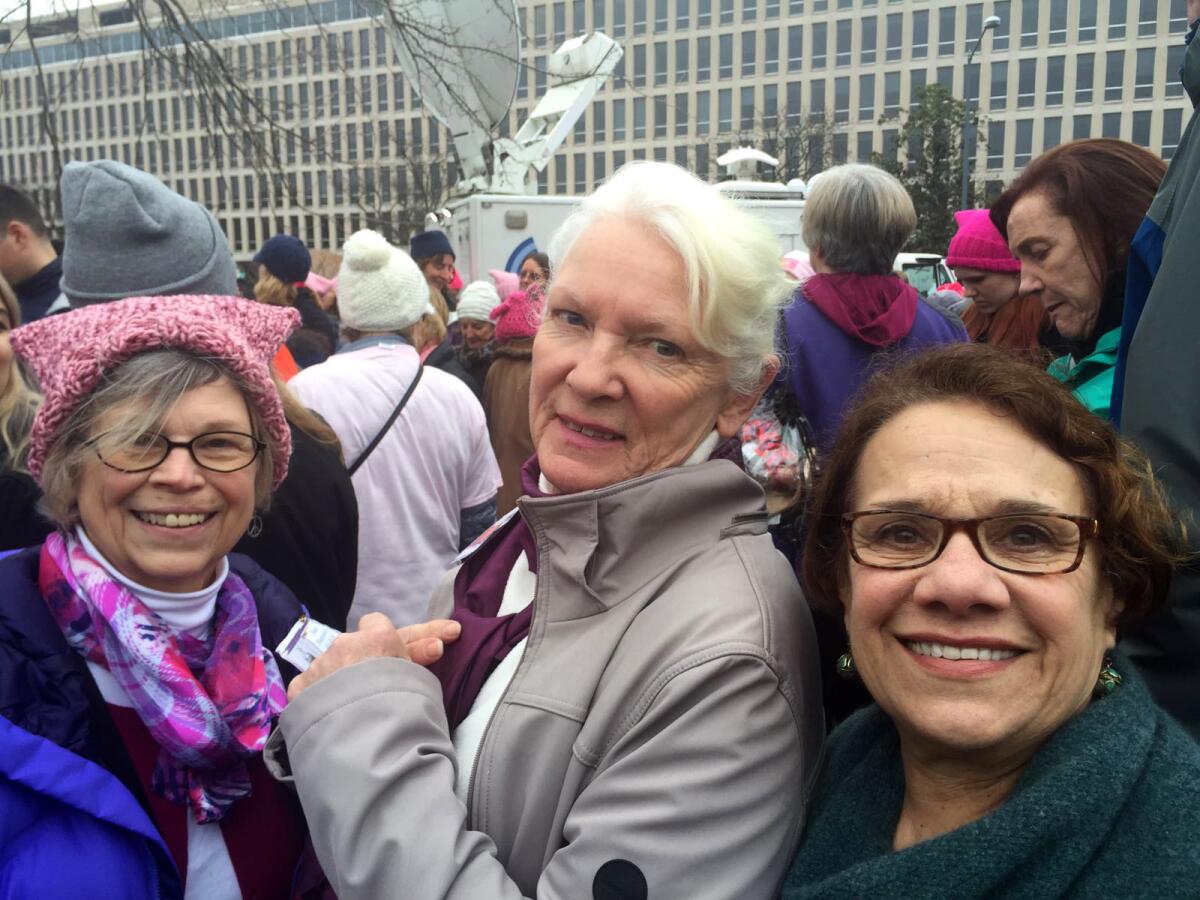
The Women’s March on Washington drew throngs of women from every generation who wanted to protest Donald Trump’s presidency and voice their belief that their rights and lives are at risk.
Angelique Munoz, 28, of San Francisco said she felt people of the millennial generation were used to getting their way until this election.
“I feel like this is the first time our generation has felt struggle and I feel we should step up,” she said.
She and her best friend from high school, Jaimie Fife of Seattle, both said the potential for the defunding of Planned Parenthood under a Republican Congress was among their top concerns. Both relied upon it when they were in college and did not have health insurance, they said. Planned Parenthood President Cecile Richards spoke at the march.
“Planned Parenthood literally saved my life,” said Fife, a 29-year-old program manager.
It was the first political march for the two friends but the fourth for Nan Purdue, 74, who’s from upstate New York. She previously marched against the Vietnam War, for civil rights and against the Iraq War.
The retired social worker said she recalled in her youth when women couldn’t get a mortgage by themselves, a credit card without their husband’s signature or work while pregnant.
“I don’t want to go back,” she said.
Purdue and two other retirees took a midnight bus from Auburn, N.Y., to attend the march.
“At our age, it’s now or never,” said Nancy Palumbo, 77. Anne Fairbanks, 70, added that she was marching for her 13 grandchildren and three great grandchildren.
“That man [Donald Trump] is a loon and I’m afraid of him,” said the retired hospital administrator
- Share via
Chelsea Handler, Dolores Huerta and others march at the Sundance Film Festival
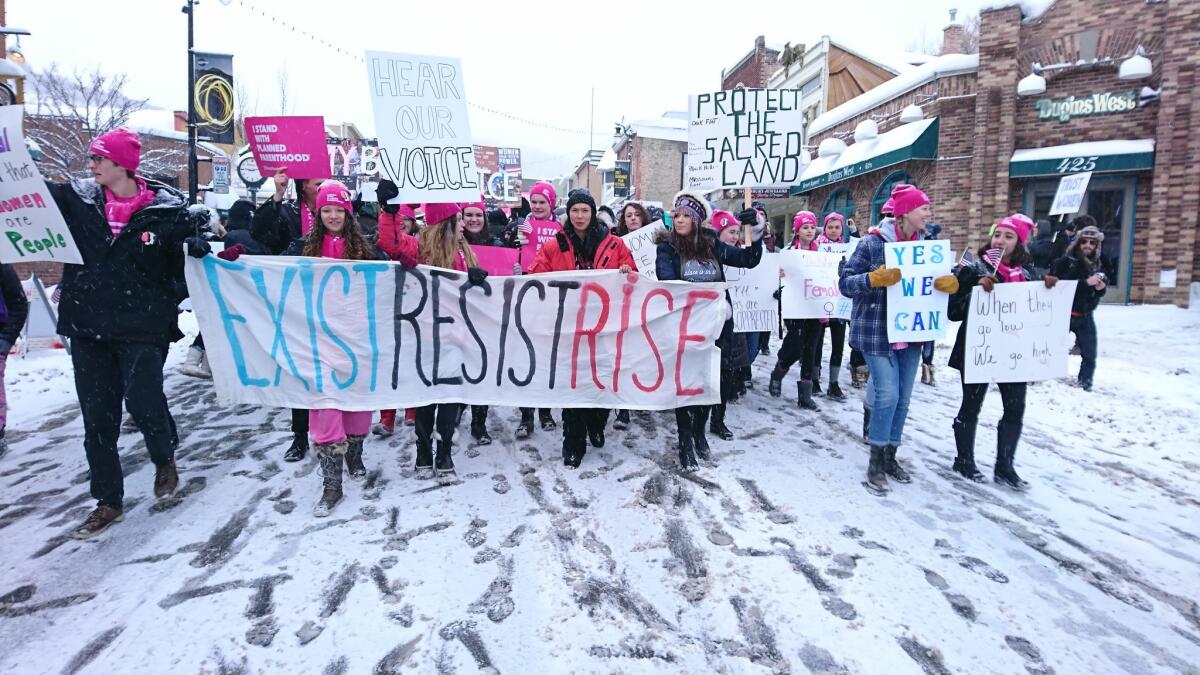
Attendees of the Sundance Film Festival took to Main Street for a women’s march in Park City, Utah. Among the celebrities spotted in the crowd were organizer Chelsea Handler, Kristen Stewart, Charlize Theron and John Legend.
“It’s not 1917, it’s 2017,” said Handler as she addressed the crowd gathered for the rally. “Who knew we had to fight for progress we already had?”
Civil rights activist Dolores Huerta was greeted by chants of “Si se puede” as she took the stage. Huerta was slated to speak at the march in Washington, D.C., before the documentary about her life, “Dolores,” was accepted into the film festival.
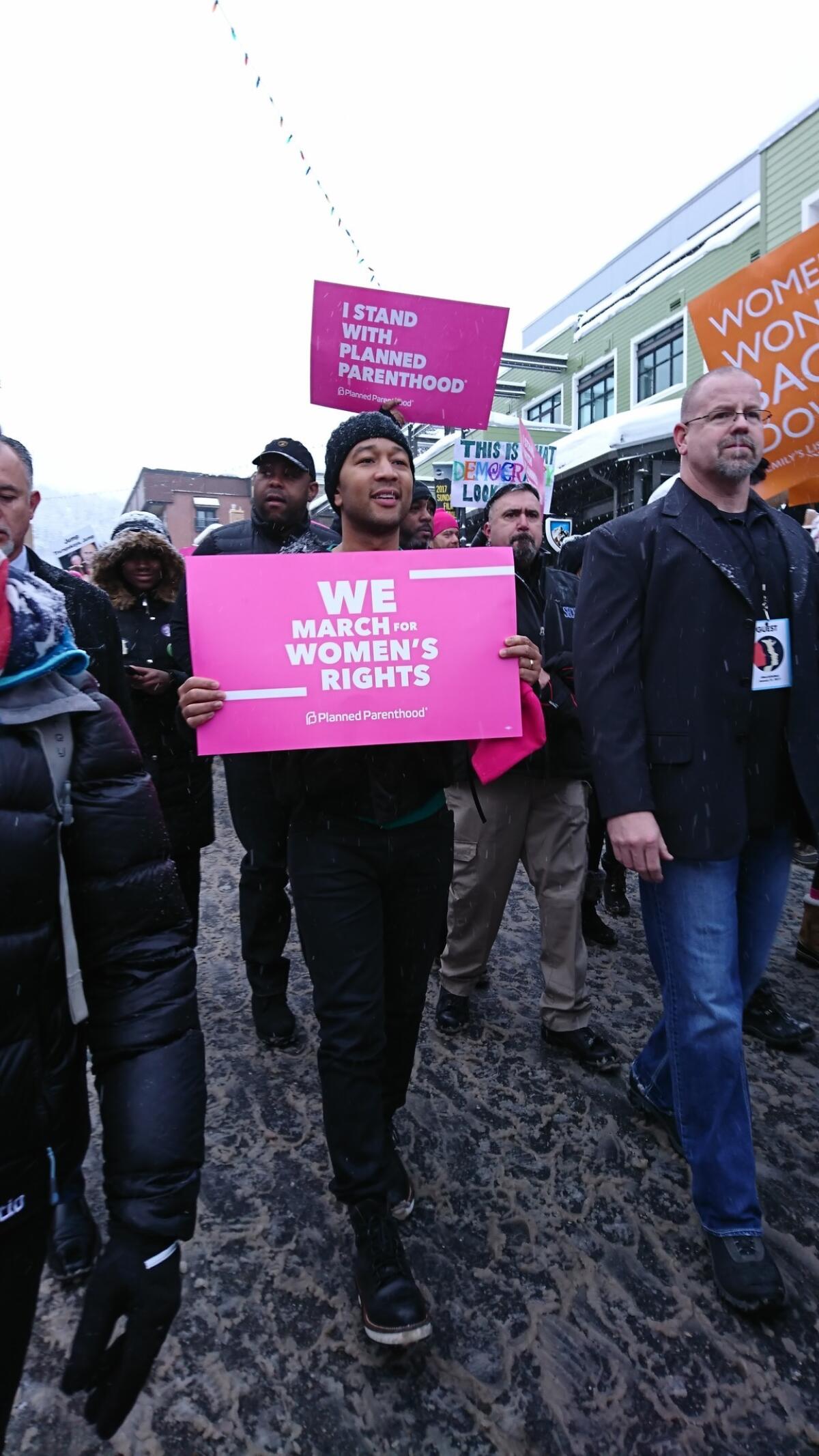

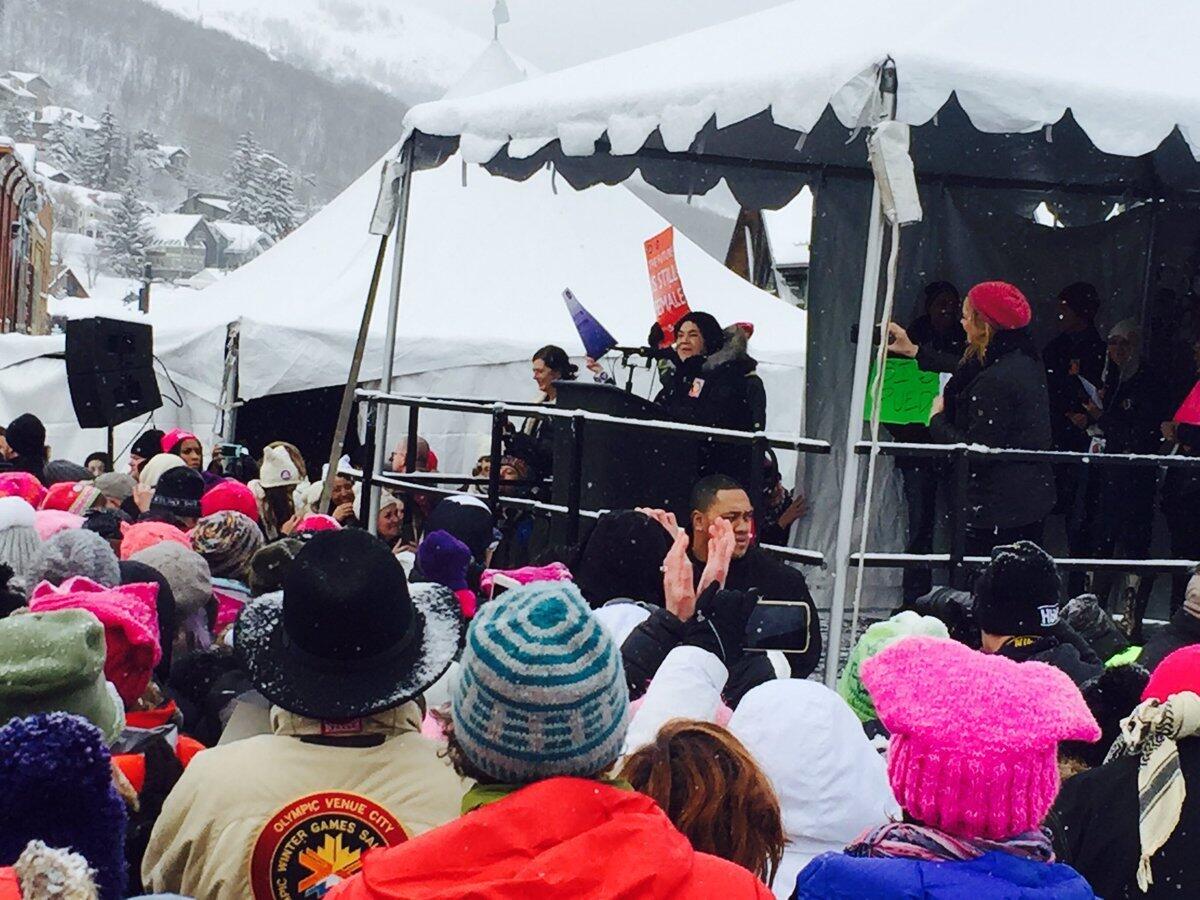
- Share via
California Trump supporters look on as women march in Washington
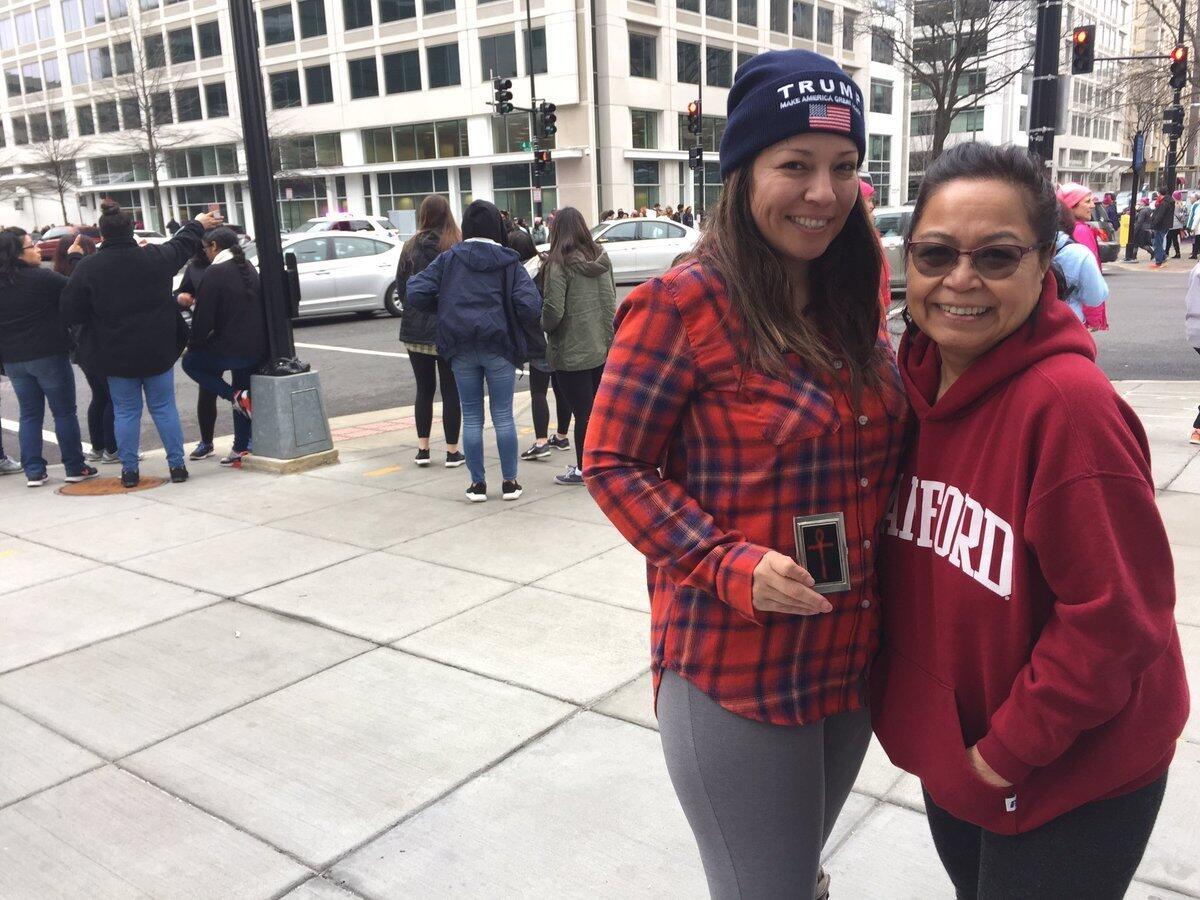
Californians Tina Bankhead and Rachel Gunther stood outside their hotel in Washington, watching as masses of women in pink caps streamed toward the women’s march. But they kept getting funny looks. Bankhead was wearing a blue cap with an American flag and the words “TRUMP Make America Great Again.”
Bankhead, a 43-year-old Mexican American woman from Orange who works in the packaging industry, stood on the corner, doing a Facebook Live video as women streamed past.
Bankhead, a volunteer for the California Trump campaign, came with Gunther, a 60-year-old fellow volunteer from Long Beach, to the inauguration and Freedom Ball. Bankhead was delighted to see Trump and the new first lady dance, and said she thought Melania Trump’s white dress was gorgeous.
“They’re bringing class back to the White House,” Bankhead said. “It was beauuuutiful.”
The women have had some awkward moments in the elevator with fellow hotel guests in pink caps.
As she entered a restroom in her Trump cap, Bankhead was stopped by a nervous housekeeper.
“Oh, they’re in there too,” she said the woman told her, referring to the marchers. Bankhead said it was OK and walked in. Inside, the women stopped talking when they saw her cap, she said.
Bankhead was a Democrat who voted for Obama but cast her vote for Trump. She work selling boxes to brokers and said that she thought it is a hardy industry because “everyone needs boxes,” but it’s lost business to China and Mexico.
“Something clicked,” she said. “We needed a change.”
As they stood on the side of the street, many people shook their heads at them as they passed.
“We’re letting them have their moment,” Bankhead said. “We had our moment yesterday.”
- Share via
Why she brought her son and nephews to the march in Houston
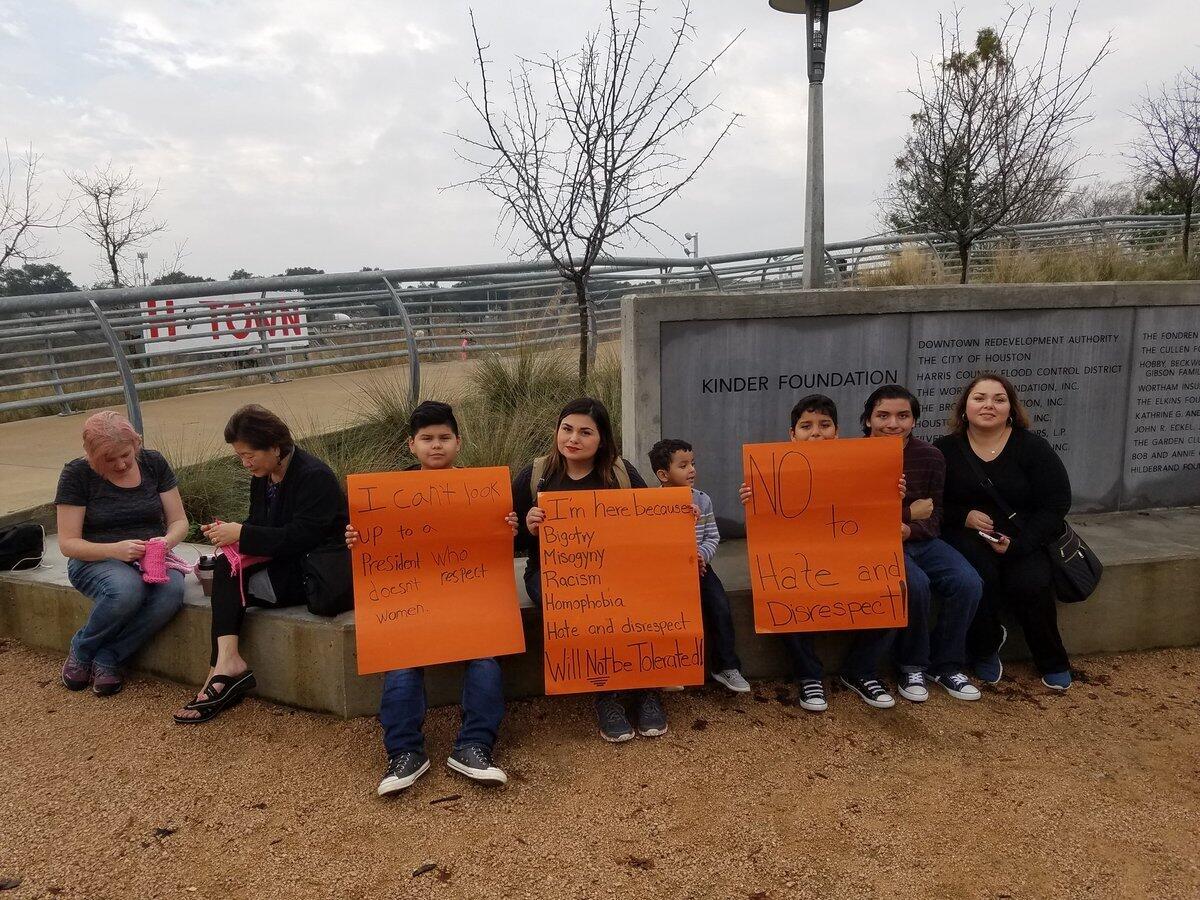
Elizabeth Arreola brought her son and three nephews to the women’s march in downtown Houston.
The night before, she had talked to her 12-year-old son, Victor, about why he wanted to march, and had him design a sign that channeled his emotions.
Victor decided to write, “I can’t look up to a president who doesn’t respect women.”
He said he wanted to join his mother, aunt and cousins at the march to make a statement: that they don’t support what President Trump has said about women and Latinos (their family is Mexican American).
“I just don’t support a person who sexually harasses women,” Victor said as several dozen protesters arrived an hour ahead of the planned march to City Hall.
His mother, a 40-year-old radio DJ, nodded her head. Her T-shirt said, “A woman belongs in the house and the senate.”
“We were just appalled at everything that came out of his mouth and what a bigot he was,” she said. “I didn’t want him to think we had to just sit and take it. We all have a voice. Marching is just a part of it. He can run for office and vote.”
Just then, an organizer with a bullhorn announced that some anti-abortion protesters were expected to arrive soon, and that participants should “keep in mind it’s a peaceful protest.”
Arreola nodded. As far as she was concerned, the protest was not only for women who support access to abortion, but for all those who oppose Trump: “The march is for anyone who has a problem with what he has said,” she said.
- Share via
Watch Ashley Judd interrupt Michael Moore at the Women’s March on Washington
- Share via
Crowds build in downtown L.A. for the women’s march
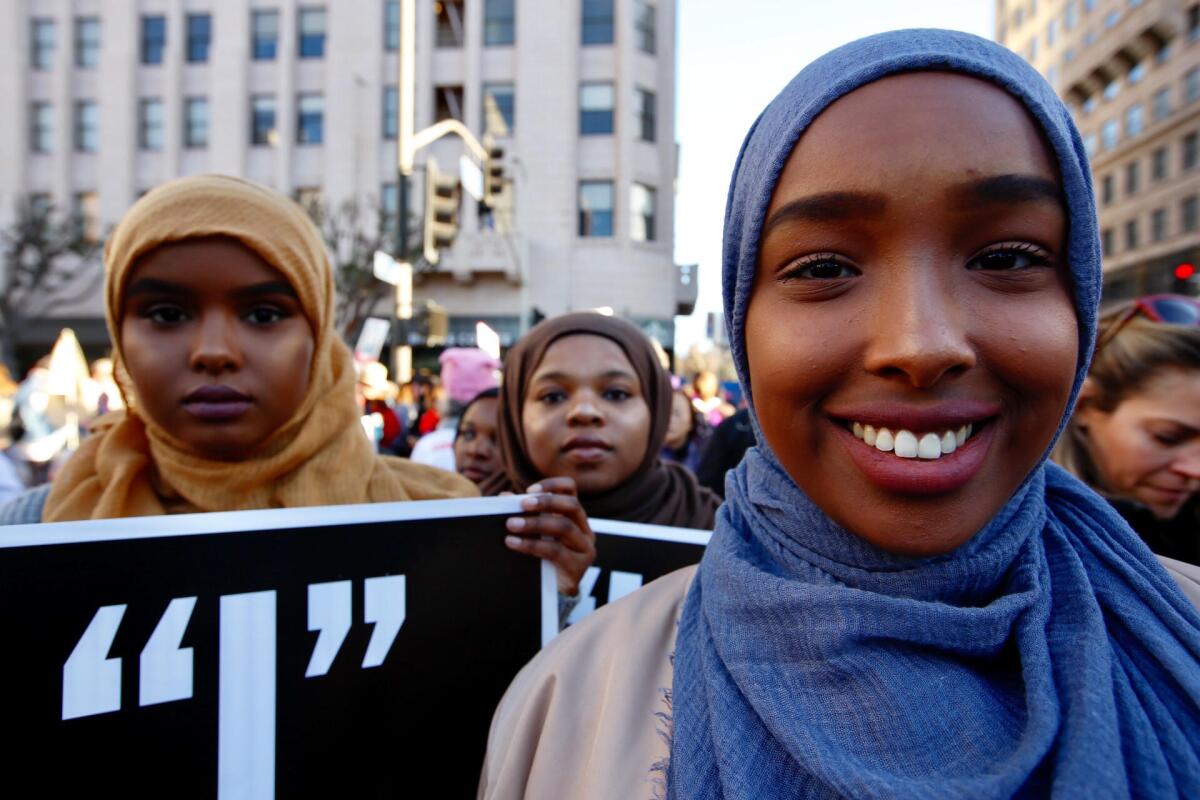
MORE PHOTOS: Scenes from the march in Washington and around the world >>
- Share via
Michael Moore: ‘We are here to vow to end the Trump carnage’
We are here to vow to end the Trump carnage.
— Michael Moore, in apparent reference to Trump’s inauguration speech, in which he referred to the end of “American carnage.”
- Share via
Metrolink jammed with passengers headed to women’s march in downtown L.A.
- Share via
Mad Grandma: She wants to save Obamacare
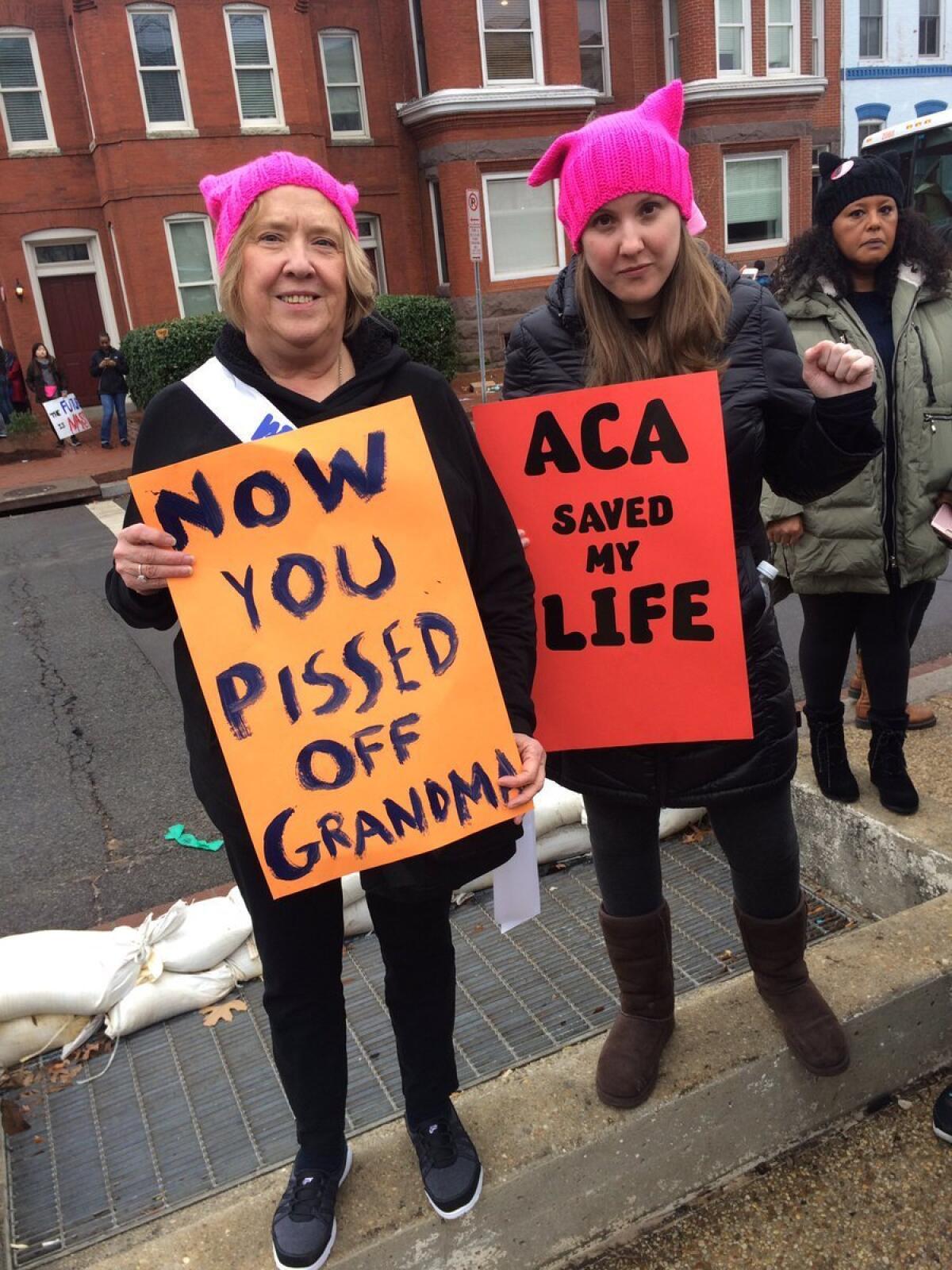
Obamacare saved her daughter’s life. Now, she’s one “pissed-off grandma.”
As hundreds of women streamed out of a Metro stop near the U.S. Capitol building, Karen Corrigan, 62, greeted them with a sign: “NOW YOU PISSED OFF GRANDMA.”
It was a popular one.
“I want a picture of another grandma who’s pissed off!” said an older woman who stopped to take a picture of Corrigan’s sign. A third grandmother quietly walked up to Corrigan, who hails from Norfolk, Va., and stood next to her in silent solidarity to have their picture taken together.
It’s Corrigan’s first time protesting since the 1960s. And her reason was standing alongside her: One of her three children, Sarah Cowherd, 31, held a sign that said, “ACA SAVED MY LIFE.”
A few years ago, Cowherd suddenly fell mysteriously ill. She and her mother traveled to clinics across the country for 2 1/2 years before doctors discovered that Cowherd had a rare autoimmune disorder that required treatments costing $30,000 to $40,000 a month, Corrigan said.
Under the Affordable Care Act, also known as Obamacare, her daughter was able to get medical insurance despite having a preexisting condition.
But if President Trump and congressional Republicans carry out their threats to repeal the law, and then don’t provide a sufficient replacement, “obviously she would not be a candidate for insurance,” Corrigan said, as her daughter stood silently next to her.
“Literally her life, the care she gets through Obamacare, depends on it,” Corrigan told a reporter. She turned to her daughter. “I’m talking on your behalf,” Corrigan told her.
“That’s OK,” Cowherd said, shrugging, like she was used to it — a mom advocating and looking out for her.
“That’s why I’m here,” Corrigan said. (Also, for her four young grandchildren.)
As the pair posed for another photo, Cowherd raised her first.
- Share via
In Raleigh, N.C., a Princess Leia sign reads: ‘We are the Resistance’
- Share via
America Ferrera at women’s march: ‘Every single one of us’ is under attack
Actress America Ferrera said “every single one of us” is under attack by President Donald Trump.
Ferrera was speaking at the start of a rally that is opening the Women’s March on Washington. She said people are gathered in the capital and across the country to say to Trump, “We refuse.”
The “Ugly Betty” star said the marchers reject demonization of Muslims. They also refuse to give up their “right to safe and legal abortions.”
Ferrera said the U.S. won’t ask LGBT Americans to go backward and won’t go from a nation of immigrants to “a nation of ignorance.”
- Share via
Crowds gather in downtown L.A. for women’s march: ‘I want my rights to be heard’
Sisters Yolanda Ramirez, 65, and Jo Ann Ramirez, 66, were part of a group that traveled from Downey and Santa Ana to attend Saturday’s rally.
“This is my first rally,” said Yolanda, who held a sign reading, “Pres. Trump, Please Lead Do Not Bully.”
The sisters said they decided to attend the rally days after the November election, and took the Metro line early Saturday to the event.
They were marching to represent women “who have no voice,” Jo Ann said. “It’s for the disenfranchised.”
Many marchers wore pink, snug-fitting hats that have become a symbol of the Trump resistance.
- Share via
‘I believe we’re being stepped on,’ one protester says as Women’s March gathers--and she wasn’t talking about the crowd
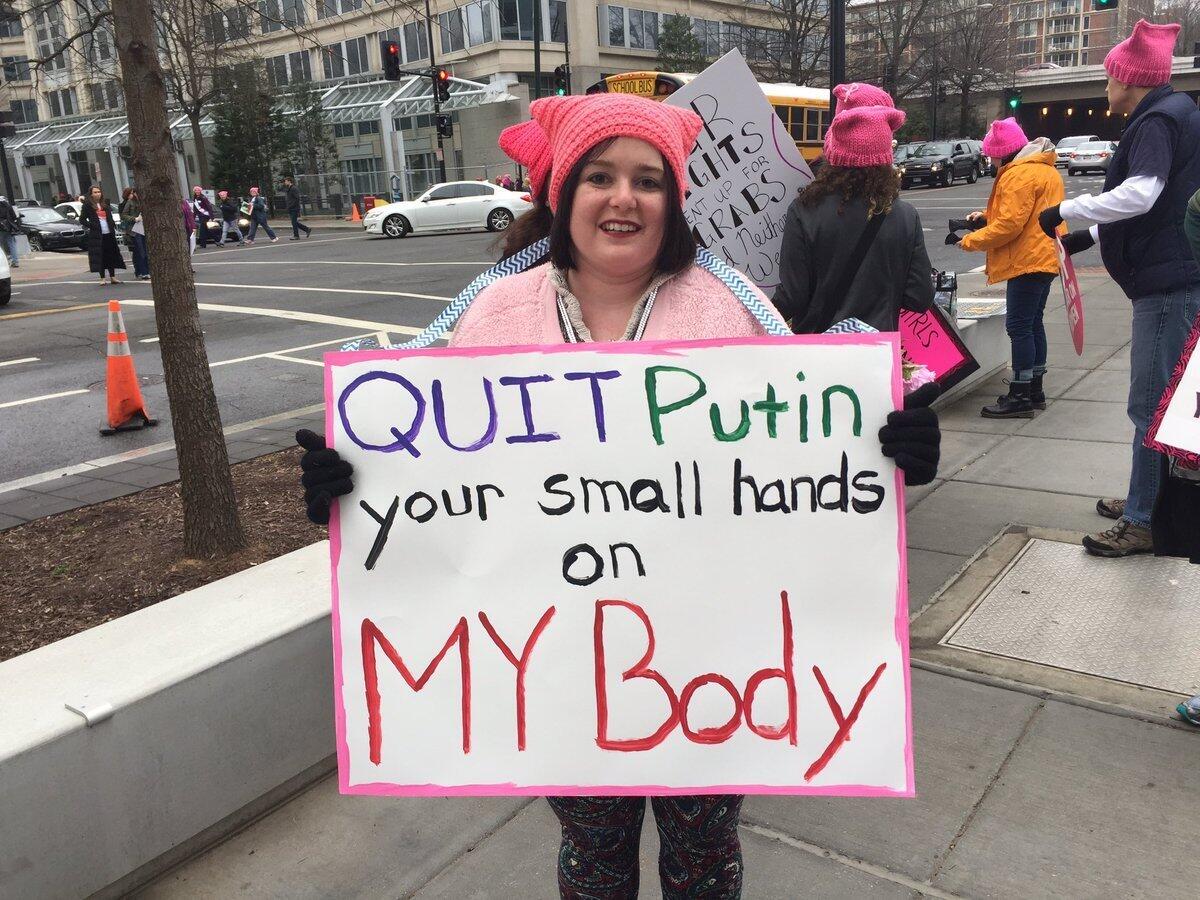
Katie Boord, 26, of Germantown, Md., wore a pink knit cap and carried a sign that said “Quit Putin your small hands on my body.”
She said she is worried about what a Trump administration will mean for women.
“I believe we’re being stepped on, and I believe our new president is going to squish us,” she said, walking down 4th Street in a massive crowd of women in pink caps.
“We need to have equal rights. We need to have Planned Parenthood because there’s so many things they offer,” she said. She is a special education para-educator.
Her mom, Deb Sullivan, walked beside her with a sign that said ,”Equal Pay Makes Cent$” She too had the pink cap.
Sullivan said she did not watch the inauguration and made sure all her TVs were shut off during Trump’s speech. She watched “West Wing” instead on Friday.
As they walked by, Los Angeles attorney Gloria Allred walked by with a group of Trump accusers holding a white banner that said “Women Seeking Justice Against Trump.”
“That’s Gloria Allred!” Sullivan said excitedly. “I’ve got to get a picture!”
She ran and successfully got a selfie.
In the crowd, Heather Brooks, 38, a small business owner from Asheville, N.C, carried a sign with Trump’s face and the words, “SO GROSS.” Lots of people stopped her to take pictures as she walked.
“I’m using his words against him,” she said. “He always says everything is ‘So great!’ Well, I think he’s so gross.”
- Share via
The march that gave ‘bra burners’ their name
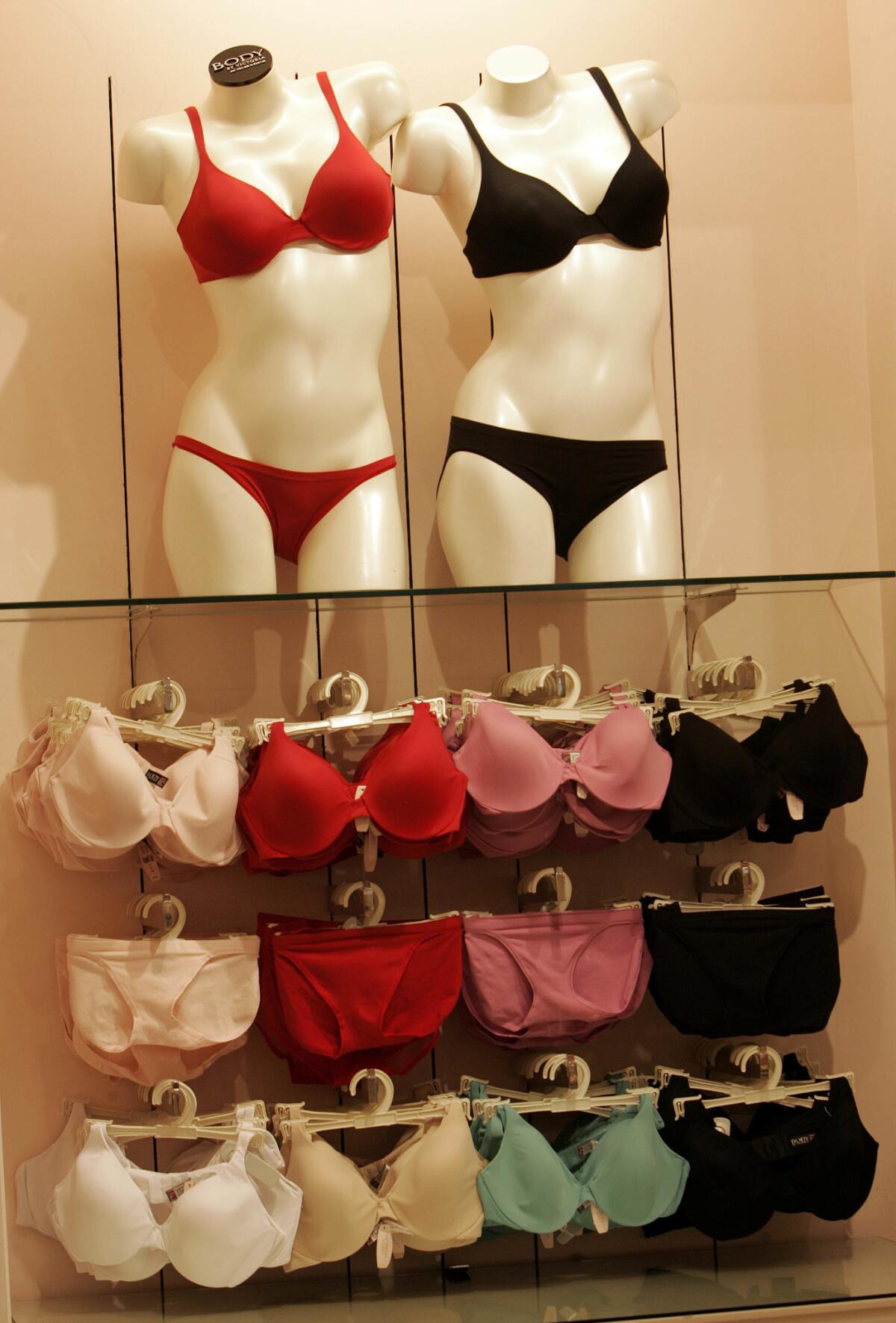
With hundreds of thousands of women expected to make history marching Saturday, another legendary demonstration -- albeit one much smaller in volume -- may be on some people’s minds.
The protest that gave “bra burners” their name took place in September 1968, when about 400 women’s liberation activists picketed the Miss America Pageant in Atlantic City, N.J. Standing on the boardwalk, they dumped what they called “instruments of female torture” -- girdles, high-heeled shoes, make-up and, yes, bras -- into a “freedom trash can.”
But they did not actually burn the bras. A New York Post article referenced the term to link the women’s protest to that of draft dodgers but was misconstrued.
Still, the myth stuck.
- Share via
Here’s where the women’s march in L.A. starts and ends
- Share via
Women who’ve accused Donald Trump of sexual harassment will be among the marchers in Washington
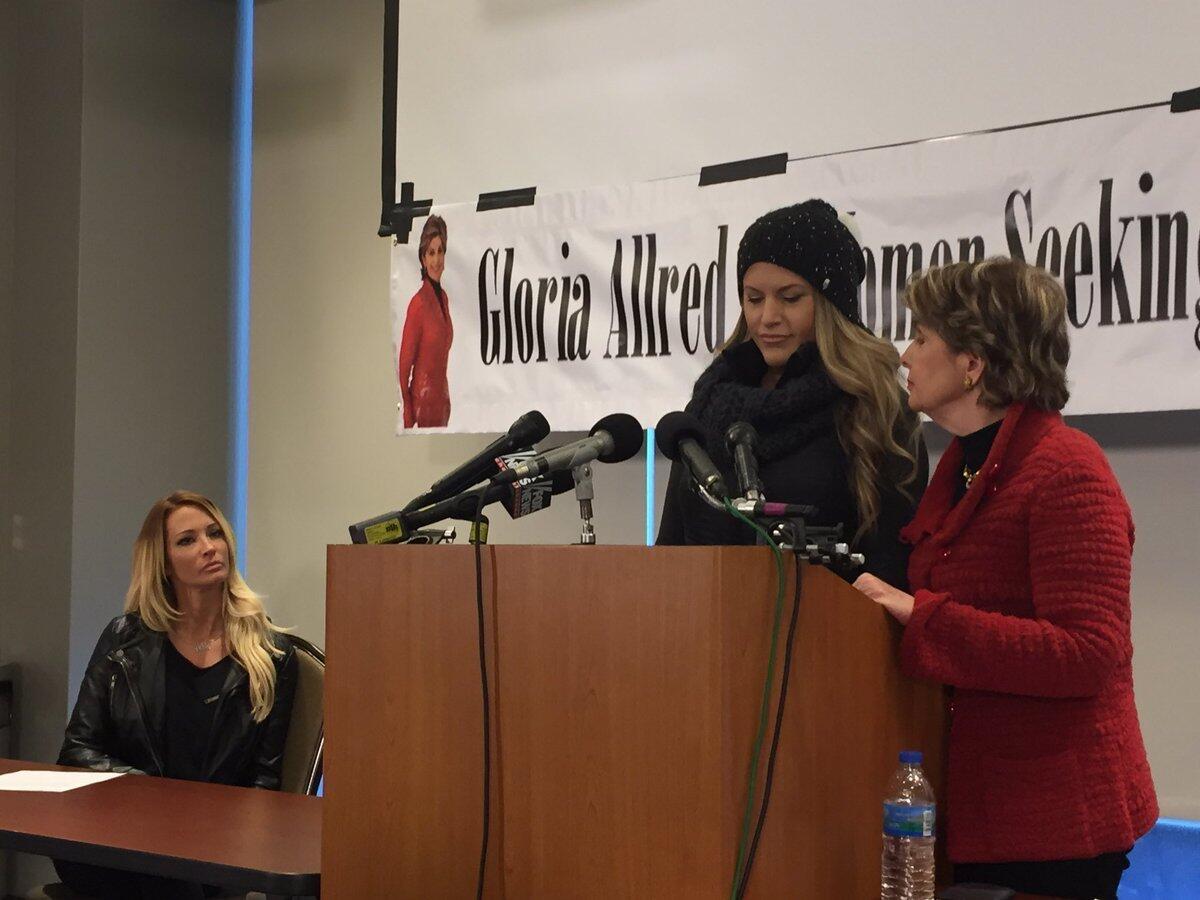
Los Angeles civil rights attorney Gloria Allred on Saturday appeared at a news conference in a downtown Washington, D.C., hotel with four women who have accused President Donald Trump in the past of sexual harassment. The women said they will be participating in the Women’s March on Washington.
“All of these women are someone’s daughter,” Allred said.
The women are:
— Summer Zervos, a former contestant on “The Apprentice” who filed a defamation lawsuit against Trump earlier this week.
— Temple Taggart, a former Miss Utah, who has said she was stunned when Trump kissed her directly on the lips without consent when she was a 21-year-old Miss USA contestant in 1997.
— Jessica Drake, an adult film actress who said Trump offered her $10,000 and the use of a private jet if she went out with him.
— Rachel Crooks, who said she was a 22-year-old receptionist at Trump Tower when Trump kissed her on the mouth outside an elevator when she introduced herself.
Allred said the women had come to D.C. to show that women, including those who have accused the president of sexual harassment, would not back down, even with Trump in the White House.
“Now more than ever, it is time to be brave and time to speak truth to power,” she said.
Trump had threatened during the campaign to sue women who had publicly accused him of assault. Allred said such women should not be “bullied, and there should never be a threat which can be interpreted as a message to silence a woman who alleges inappropriate sexual conduct.”
Drake said she was “horrified” by the new administration “and fear the consequences it will have, and as a woman who has used the services of Planned Parenthood in my adolescence, I want to use my platform to speak for others who cannot.
“Mr. Trump,” she said, “we are watching.”
Taggart said she couldn’t shake the image of Trump mocking a disabled reporter and “how he has belittled or bullied anyone with differing views, opinions, beliefs or backgrounds.”
Taggart, choking up as she spoke, said that she had a disabled brother who committed suicide last month and that she was marching in his honor. She said he left a note begging people to “stop the hate” and “love people unconditionally.”
“I hope to share my brother’s message that we need to stop the hate and start looking in the inside so we can see that each individual matters and each life is truly priceless,” she said.
- Share via
Organizers up their crowd estimate for Women’s March on Washington as D.C. Metro appears packed
There were early signs across Washington that Saturday’s crowds could top those that gathered Friday to watch President Trump’s inauguration.
D.C.’s Metro stations were reported to be packed, with many unable to get on trains because they were loaded to capacity with people headed to the National Mall.
A city official in Washington says organizers’ turnout estimate for the Women’s March on Washington now stands at 500,000, which is more than double their initial predictions.
The march’s National Park Service permit estimated a turnout of 200,000, but the District of Columbia’s homeland security chief had previously predicted turnout would be higher.
- Share via
In New York, the demonstrations are sky-high
A large women’s march was scheduled in New York City on Saturday, and it appeared to be officially sanctioned: Chirlane McCray, the wife of Mayor Bill de Blasio, was on the program to give opening remarks.
But the Big Apple was already in full demonstration mode a day earlier.
“WE OUTNUMBER HIM! RESIST!’’ was the message soaring past the Statue of Liberty across New York Harbor hours before Donald Trump’s inauguration on Friday.
The banner was tugged by a small airplane that had reportedly been hired for a three-hour run by a woman from Seattle. The plane was spotted by thousands of people in New York and New Jersey, who posted their descriptions and photographs on Twitter. The best shots came out of Hoboken, N.J.
Another banner was hung from the Queensboro Bridge reading “BRIDGES NOT WALLS,’’ a reference to Trump’s plan to build a wall on the Southern border to keep out Mexicans.
Although Trump is a native New Yorker, born and bred in Queens, he received only 19% of the vote in overwhelmingly Democratic New York City.
- Share via
At inauguration and the women’s march, it’s all about the visuals
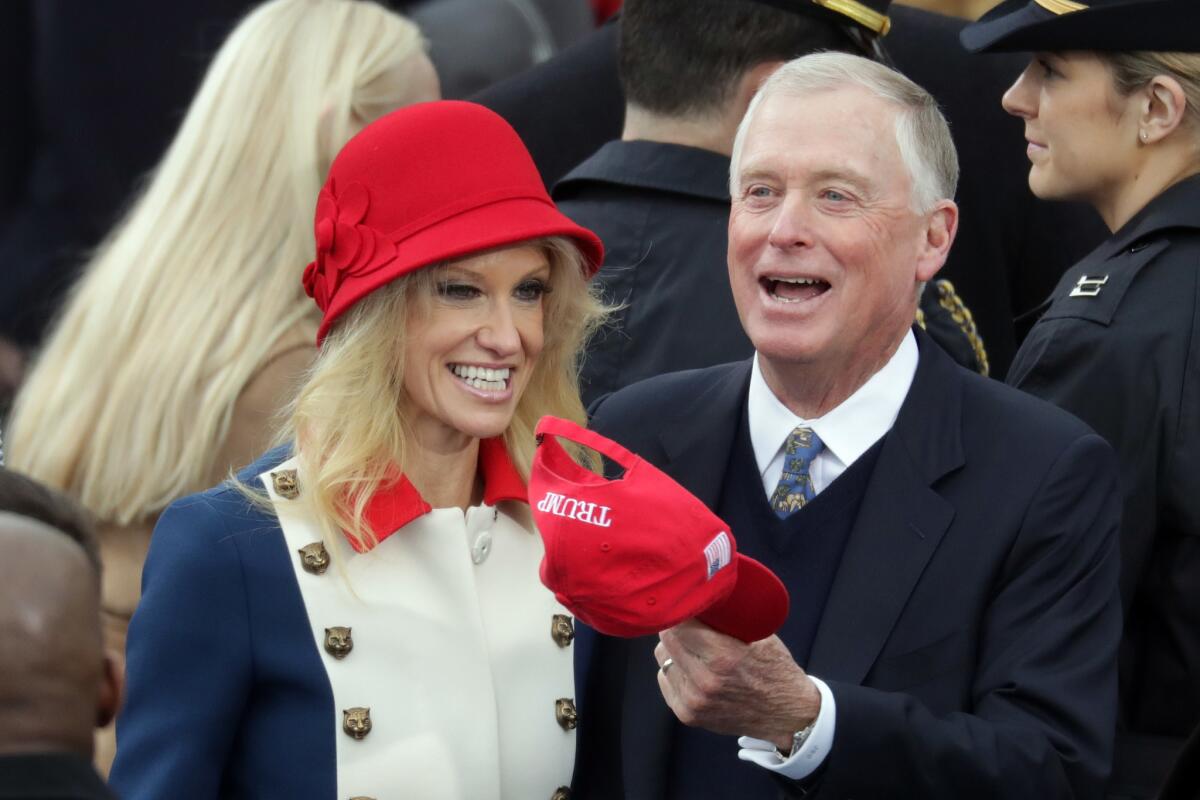
In this digital age, it’s all about the visuals, and that’s certainly the case this week in Washington, both at the inauguration of President Trump on Friday and the Women’s March on Washington the day after.
There’s been a run on “Nasty Women” T-shirts, which appropriated a term Donald Trump used to describe opponent Hillary Clinton during a presidential debate last fall.
A group of women in Los Angeles got the idea of knitting pink hats with cat ears ahead of the march, and the hats went viral.
And on Friday, the significance of the cat buttons on the coat that Trump counselor Kellyanne Conway wore to the inauguration became the subject of much conjecture. And how about that bright red hat?
The arresting visuals aren’t confined to clothing. Artists have been busy designing posters and banners for participants to carry at the march too. Here are some of the items you can expect to see on this day of protest:
Official Women’s March on Washington T-shirts
White and purple sashes inspired by the Suffragettes
‘Don’t Trump Women’ masks
‘Women Unite’ T-shirts or posters.
- Share via
California Rep. Jackie Speier holds an Equal Rights Amendment rally just before the big women’s march
Chants of “We’re not going back” and “ERA” echoed down the halls of the Rayburn House Office Building on Saturday morning.
Three hundred or so women and men, many of them Californians, gathered in the building two hours before the Women’s March on Washington for breakfast and a rally led by Rep. Jackie Speier (D-Hillsborough) for a still hoped-for Equal Rights Amendment to the U.S. Constitution.
Speier has taken up efforts to remove the 1982 deadline for two-thirds of states to approve the Equal Rights Amendment, allowing the proposed constitutional amendment to move forward without having to start over.
The ERA was first introduced in 1923, and again in each session of Congress until it passed in 1972. Thirty-five states ratified the amendment before the 1982 deadline (including a three-year extension) for two-thirds of states to pass it. It was just three states short of adoption. Since then, members of Congress have repeatedly tried to eliminate the deadline. Other members have sought to start from scratch.
Feminist Majority Foundation President Eleanor Smeal told the crowd that the 2016 election showed “we need it now” and said women shouldn’t have to fight for rights every four years.
“We are going to be heard,” Smeal said. “We’ve only been fighting for this doggone thing since 1923.”
Several speakers noted legal and social reasons for the amendment.
Actress Patricia Arquette, who attended the meeting, focused on the backlog of testing rape kits and the hurdles some states have to preserving the evidence until it can be tested. In some states, women have to make a request every six months so the untested kit will not be destroyed.
“We need the legal scrutiny that would be afforded us with the Equal Rights Amendment,” she said.
- Share via
Women’s solidarity marches unfolding in Europe
As thousands begin gathering in Washington, D.C., for the women’s march, solidarity marches are unfolding in cities around the globe.
In Europe, marchers assembled in Budapest, Hungary; Amsterdam; Berlin; Dublin; and Florence, Italy.
Here’s the scene near the U.S. Embassy in London:
- Share via
Here’s where all those pink hats at the women’s march originated
You’re seeing a bunch of pink hats on Saturday, and that was exactly the plan of the women who started knitting them in Los Angeles.
“We want to see a sea of pink” on the National Mall, said Kat Coyle, the owner of the Little Knittery in the neighborhood of Atwater Village.
- Share via
A brief history of women’s demonstrations, from suffragists to reproductive rights
The Women’s March on Washington joins a long tradition of women’s protests in the U.S. capital.
The suffragists
The day before President Woodrow Wilson’s inauguration in 1913, more than 5,000 women, accompanied by nine bands and about 20 floats, marched in Washington to demand the right to vote.
Among the marchers was a group of women who had hiked all the way from New York for the occasion. According to a Library of Congress account of the event, the parade even included “four mounted brigades” and “three heralds.”
When President Wilson and his staff were greeted in Washington by an empty Union Station instead of welcoming crowds, they wondered where all the people were.
Watching the suffragists, it turned out.
Organized by Alice Paul and led by Inez Milholland, who sat astride a white horse wearing Joan of Arc robes, the marchers walked down Pennsylvania Avenue to the Treasury Building. Along the way, they were “jeered, tripped, grabbed, shoved, and many heard ‘indecent epithets’ and ‘barnyard conversation,’” according to the Library of Congress account. More than 100 were sent to a local emergency room.
Public outrage over how the women were treated helped galvanize support for the suffrage movement. The 19th Amendment granting women the right to vote was ratified seven years later.
Equal Rights Amendment
Marches in support of the Equal Rights Amendment took place across the country in the 1970s and early 1980s. Congress had approved the amendment in 1972, but 38 states needed to ratify it within seven years for it to become law.
The biggest march occurred in Washington in 1978, when the National Organization for Women organized about 100,000 supporters to rally for an extension of the ratification deadline. Though they did receive an extra three years, several states remained resistant, and the amendment died in 1982, having been approved by 35 states.
Million Mom March
On Mother’s Day in 2000, Donna Dees-Thomases and about 750,000 others marched on Washington to advocate for stricter gun control. An estimated additional 250,000 people marched in satellite rallies around the country.
Dees-Thomases had started organizing the year earlier, after a shooting at a summer camp in Granada Hills in Southern California that injured five people, including three children.
The marchers were joined by then-First Lady Hillary Clinton, Sen. Dianne Feinstein (D-Calif), Tipper Gore and Rosie O’Donnell, among other celebrities. The U.S. Conference of Mayors presented a “wall of death” displaying the name of 4,001 victims of gun violence.
March for Women’s Lives
In 2004 more than half a million people marched in Washington in support of reproductive and women’s rights. Clad in hot pink, yellow and purple T-shirts and carrying signs that read “Keep Your Laws Off My Body” and “My Body, My Choice,” the demonstrators protested George W. Bush administration policies on women’s health, including his stance on funding international family planning and a law he signed banning “partial-birth” abortions.
- Share via
Here’s a look at that glass ceiling that didn’t get shattered in 2016
It turned out that the ceiling was made not of glass, but reinforced concrete.
At least that is what it felt like to many women who had been getting ready to pour Champagne in November to celebrate the election of the first female president of the United States.
It soon became clear that the nation’s 45th U.S. president would be the 45th man to hold the post, and Hillary Clinton, the woman many had expected to break the biggest gender barrier of them all, would be an also-ran for the nation’s highest office.
In the years to come, political scientists will ponder to what extent gender was a factor in the electorate’s rejection of a candidate with an Ivy League law degree, three decades of public service, a famous surname and the endorsements of a broad swath of newspapers and political leaders.
- Share via
Why are you marching?
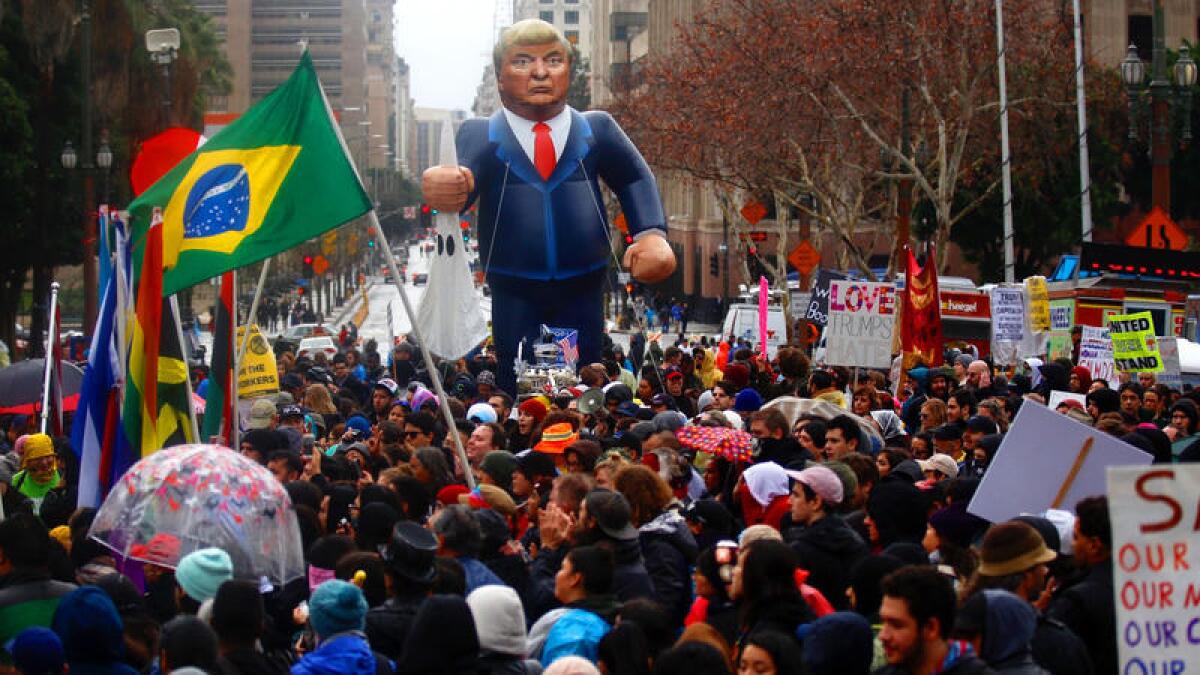
Hundreds of thousands of demonstrators are expected to participate in the Women’s March on Washington, D.C., and more than 600 sister marches in every state and dozens of foreign countries Saturday. Protesters say their goal is to make their voices heard on civil rights issues on President Trump’s first full day in office.
In Los Angeles, nearly 80,000 have signed up on Facebook to march. The lineup of speakers includes L.A. Mayor Eric Garcetti, former Mayor Antonio Villaraigosa and U.S. Rep. Judy Chu (D-Monterey Park).
- Share via
Large crowds flocking toward D.C. march
- Share via
Pink hats and Obama-esque chants in the D.C. Metro ahead of women’s march
- Share via
Rift over abortion keeps some women away from marches
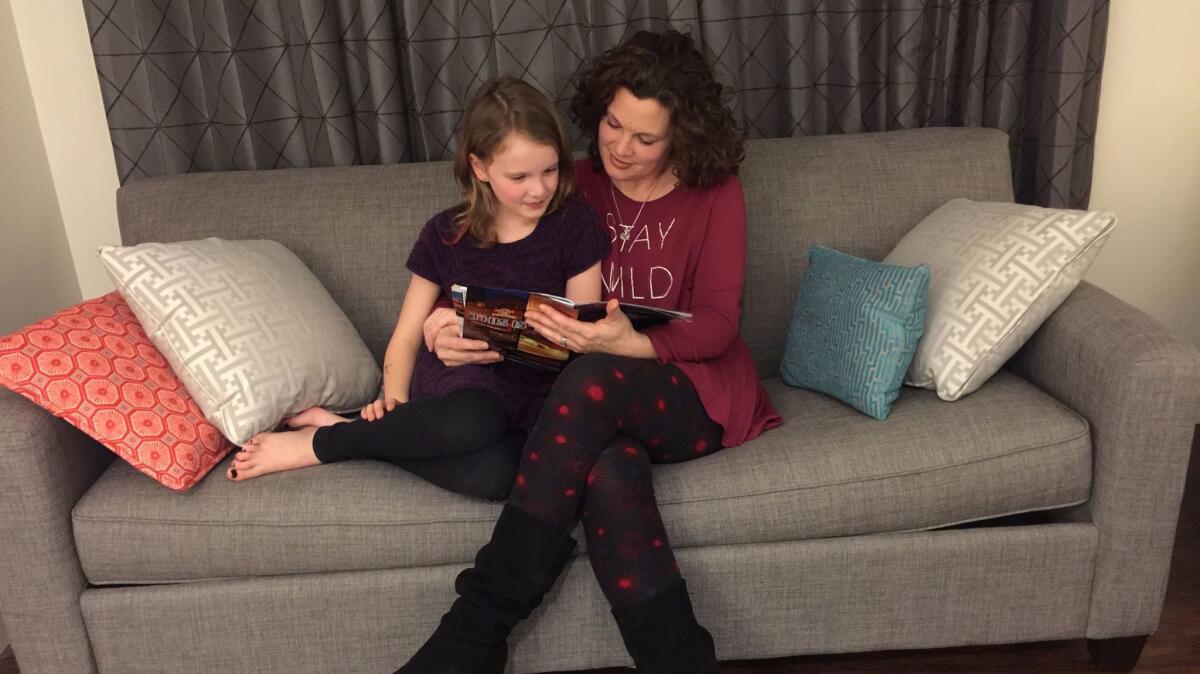
Melissa Linebaugh was looking forward to taking part in the Women’s March on Washington with her mother and her 9-year-old daughter.
A self-described Christian liberal from Dover, Pa., she was horrified by President Trump’s rhetoric toward women and minorities during the campaign. This was their chance, she thought, to stand with other women in support of a more inclusive and equal world.
Then she read that the organizers had refused to partner with a group of antiabortion feminists. Would she, Linebaugh wondered, be welcome?
“As liberal as I am, my one real issue that I struggle with is abortion,” she said.
She was not alone. Across the United States, many women who oppose abortion decided to stay away from the marches in Washington and around the country Saturday.
- Share via
Before the Women’s March on Washington there was the Million Woman March…and the Million Man March
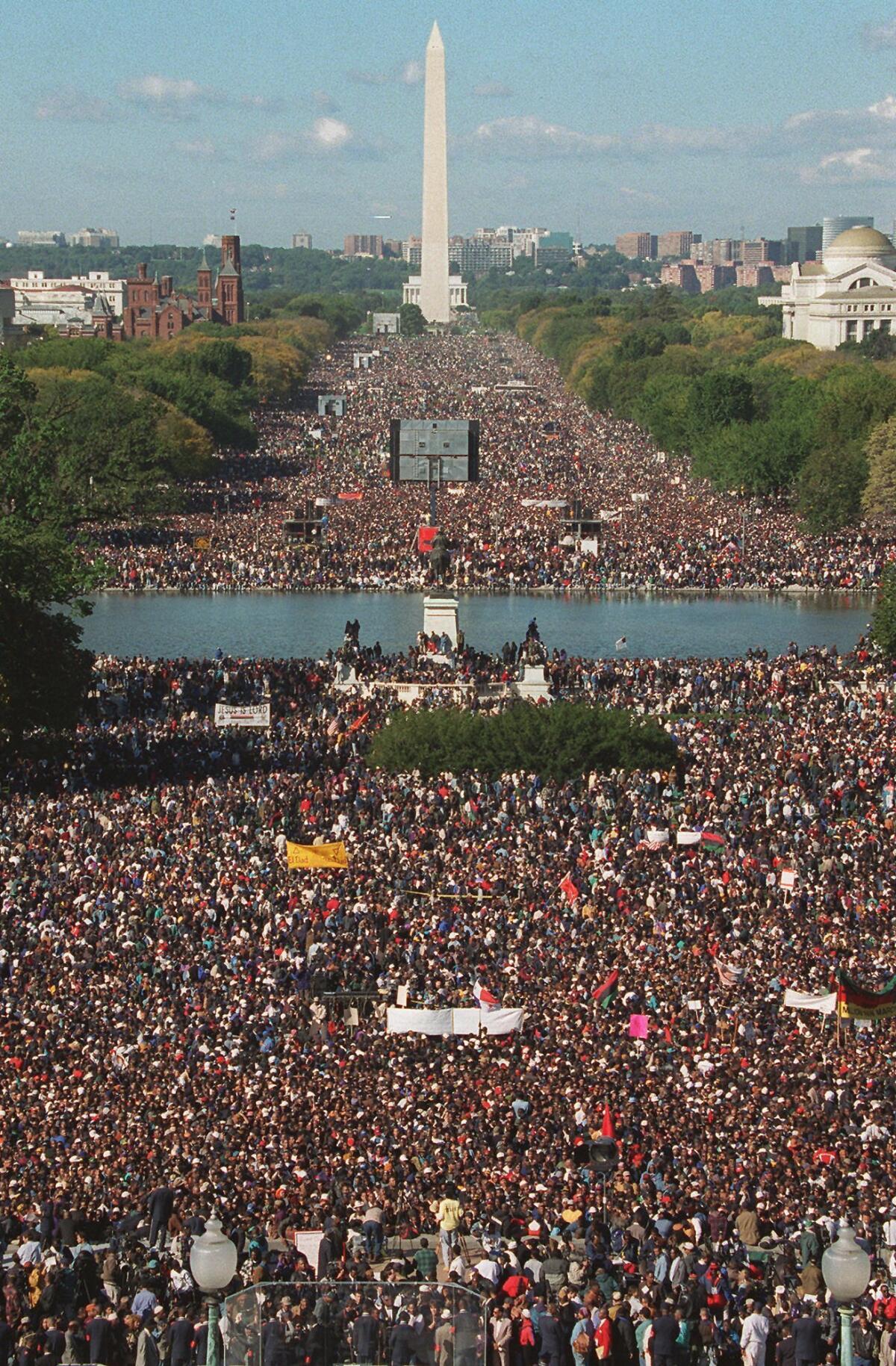
Saturday’s Women’s March on Washington was originally named the Million Woman March. But some people noted the same name was used for a march which took place in Philadelphia in 1997 and focused attention on the experience of black women in America.
Even before that there was the Million Man March in 1995. Organized by Nation of Islam leader Louis Farrakhan and former National Assn. for the Advancement of Colored People head Benjamin F. Chavis Jr., the march focused on atonement and personal responsibility within the black community, especially among men. It was a contrast to civil rights marches in the past which had called for changes in society overall..
In a speech that lasted over two hours, Farrakhan called on participants never again to commit violence, use drugs, abuse women or children or otherwise degrade themselves or their communities.
The Nation of Islam estimated the crowd at 1.5 million to 2 million, but the National Park Service put the number closer to 400,000, based on aerial photographs. (The agency divided the Mall into grids of equal size, estimated the density of each and assigned a number of people per square foot.)
March leaders accused the Park Service of racism and threatened to sue. A Boston University professor stepped in to re-do the math, concluding that about 837,000 people attended. But his calculations had a margin of error of 20%, meaning the actual figure could be anywhere between 670,000 and 1 million.
The controversy was so great Congress barred the National Park Service from counting crowds.
Two years after the Million Man March, two grassroots activists organized the Million Woman March in Philadelphia for black women to come together and address the ills in their communities. They walked for two miles past symbolic settings, including the Liberty Bell and City Hall, spilling onto the sidewalks of Benjamin Franklin Parkway and up the steps of the Philadelphia Art Museum.
How many people attended was anyone’s guess.
- Share via
How the women’s march came into being

It all started on what, for Teresa Shook, was an unsettling night. It was Nov. 8 and Donald Trump had just won the presidency.
“I went to bed the night of the election just discouraged and woke up feeling worse the next day thinking, ‘How could this be?’ I was just sad and dumbfounded,” Shook told a local TV station.
She decided to do something about it.
The next night, with some help from friends online, the retired attorney and grandmother living in Hawaii created a Facebook event page calling for a march on Washington after Trump’s inauguration. Before she went to bed, she had about 40 responses. When she woke up, she had more than 10,000.
On the other side of the country, Bob Bland had the same idea. A New York-based fashion designer who had grown a following after designing “Nasty Woman” and “Bad Hombre” T-shirts, Bland proposed a “Million Pussy March.”
“I think we should build a coalition of ALL marginalized allies + do this,” Bland wrote on Facebook on Nov. 10. “We will need folks from every state + city to organize their communities locally, who wants to join me?!?”
Bland, working with others, consolidated various protest pages, including Shook’s, that had cropped up on Facebook and recruited three longtime, New York-based activists to be co-chairs of the national march: Tamika Mallory, a gun control advocate; Carmen Perez, head of the Gathering for Justice, a criminal-justice reform group; and Linda Sarsour, who recently led a successful campaign to close New York City public schools on two Muslim holidays.
Shook helped plan a march in Hawaii, but does not have a leadership role on the national level.
Not only did these women bring organizing chops to a rapidly growing movement, they also brought diversity to a campaign that was already being criticized for lacking it.
Settling on what to call the march took a few days. “Million Pussy March” perpetuated a slur used by Trump; another early name, “Million Woman March,” seemed too reminiscent of a 1997 protest by African American women of the same name.
The organizers eventually adopted the title “Women’s March on Washington,” invoking Martin Luther King Jr.’s civil rights march of 1963. They even got the blessing of King’s daughter Bernice.
The march is shaping up to be one of the largest inauguration demonstrations in history, with thousands expected. Close to 700 sister marches involving 2 million people are planned across the U.S. and around the world, according to the Women’s March website.
- Share via
Women’s March on Washington crowd shaping up to surpass Trump’s
The Women’s March on Washington and simultaneous demonstrations across in the country Saturday are taking shape as one of the largest mass demonstrations in recent U.S. history, rivaling the civil unrest that swirled around the Vietnam War.
While it’s not expected to be as large as the Million Man March against racism in 1995 or the Million Woman March two years later in in Philadelphia, the event could wind up being a bigger draw than Trump: 1,200 bus parking spaces have been reserved, three times as many as for the inauguration Friday.
The march embraces a grab bag of progressive causes, its website listing more than 300 partners promoting causes including anti-bullying, gun control, climate change and transgender rights.
And it’s not only women. Men from across the country will be part of the demonstrations.
- Share via
What you need to know if you’re planning to attend the Women’s March on Washington
Thousands of people will descend on the National Mall on Saturday for the Women’s March on Washington. If you’re one of them, here’s what you need to know.
The event is scheduled to begin at 10 a.m. EST with a rally featuring speeches and performances at the intersection of Independence Avenue and 3rd Street NW, near the U.S. Capitol.
At 1:15 p.m. the group will begin to march, following a route west on Independence Avenue SW, north on 14th Street SW and west on Constitution Avenue NW until 17th Street NW, where it will disband.
Participants can download an app for updates.
Transportation
If you’re planning to drive, be prepared for heavy traffic and rolling road closures along portions of the march route, as well as all-day closures in the vicinity. The Metropolitan Police Department has a full list. For parking, your best bet is a Metro station lot or garage, free on the weekends.
If you’re planning to take public transportation, Metro will open at 5 a.m. Up to two dozen additional trains will be in service and no track work is scheduled. Consider buying a Metro card (called SmarTrip) in advance; these cards can be purchased at all metro stations as well as at some CVS and Giant stores.
You can also ride your bike; bike racks are available across downtown and the national mall.
For those requiring disability accommodations, enter through the ADA-accessible route on 4th Street between C Street and Independence Avenue.
What to bring
March organizers are encouraging participants to check the weather and dress warmly, but to travel light. Here are some of the restrictions:
- No weapons of any kind, bicycles, folding chairs or flagpoles will be allowed in the rally or march areas. (Flags and banners without poles are OK.)
- All backpacks and bags may be subject to search, and only clear backpacks smaller than 17”x12”x6” will be permitted.
- People wishing to bring a meal can carry an additional large plastic (12”x12”x6”) or gallon bag.
For parents
Mothers who need baby bags or breast pumps can bring them as long as they fit in the appropriately sized clear backpacks. There will be lactation stations and bathrooms along the march route. Organizers also say marshals will be available to provide assistance, and they will set up a reunification tent to help connect parents and lost children.
For noncitizens
Participating in a peaceful march does not carry immigration consequences, according to the National Lawyers Guild, which has prepared a resource guide for immigrants attending the march. But engaging in disorderly conduct or civil disobedience could result in an arrest and conviction.
Can’t make it to Washington?
Watch a live stream of the march and join us for updates from around the country.